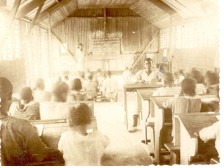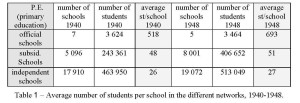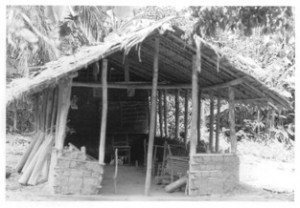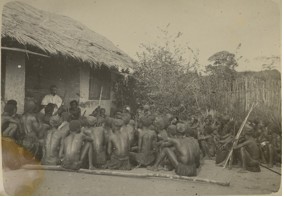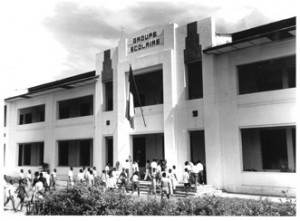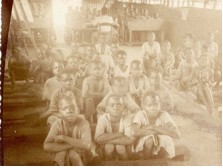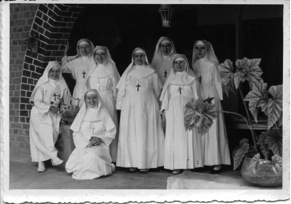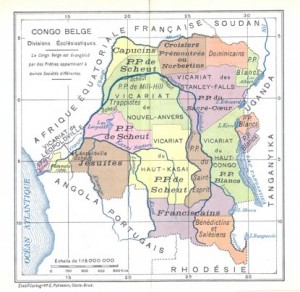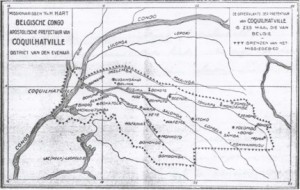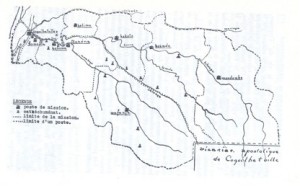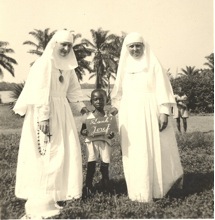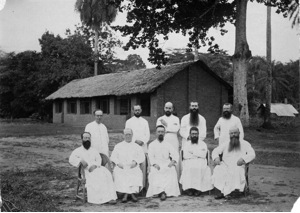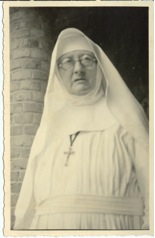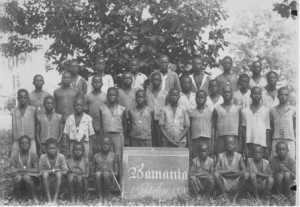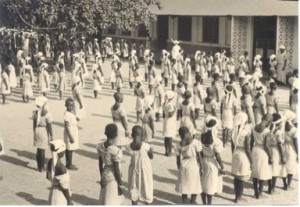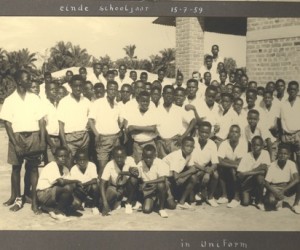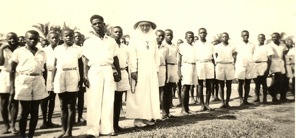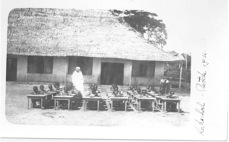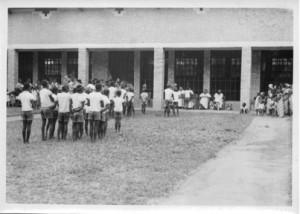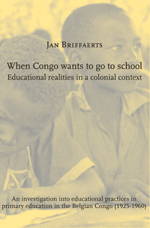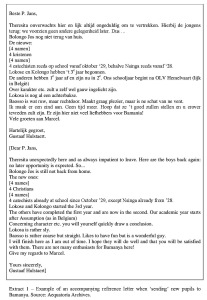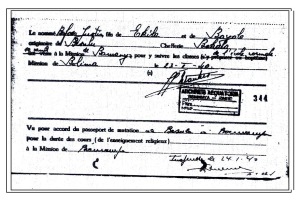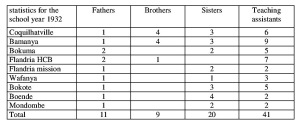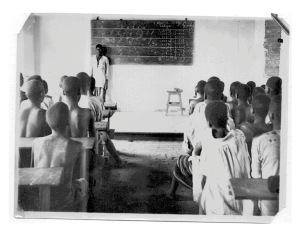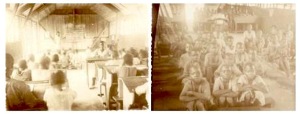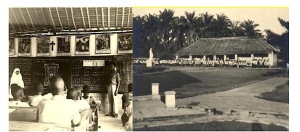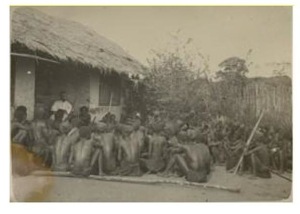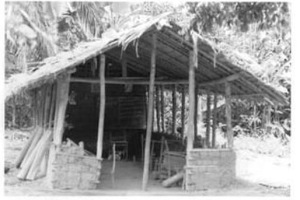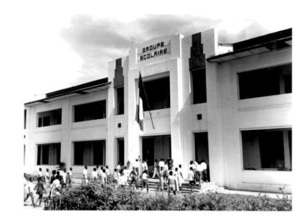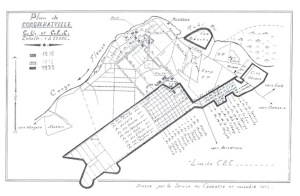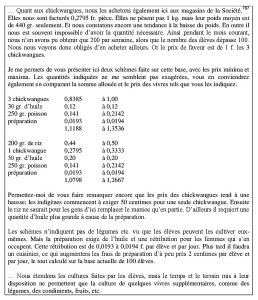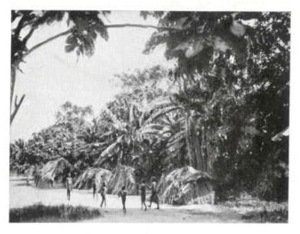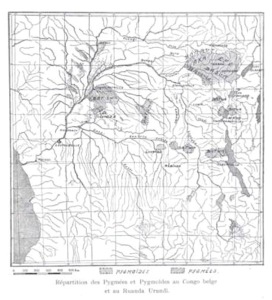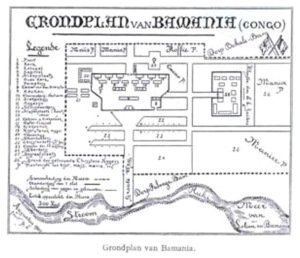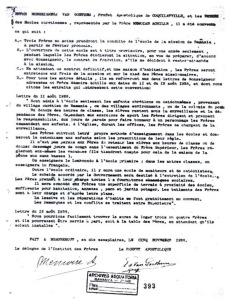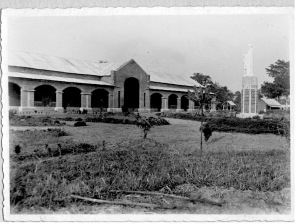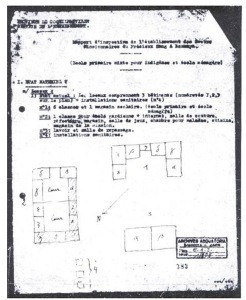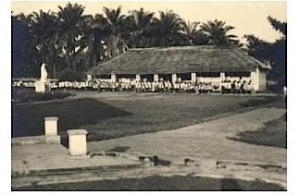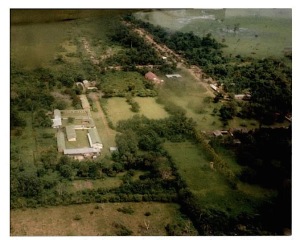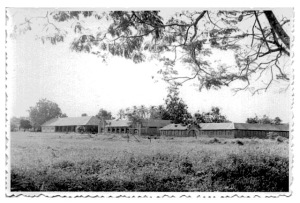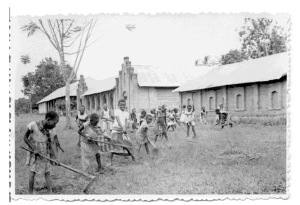When Congo Wants To Go To School – Educational Organisation In The Belgian Congo (1908-1958)
Contexts
The first part of this study will concentrate on the wider environment within which daily practice of colonial education is situated. It progresses in three stages in accordance with the aim of the research. Three chapters correspond with these three stages. The general, macro-institutional context of the phenomenon of colonial education is considered in the first chapter. This includes a discussion of the organisational development and politico-strategic factors that influenced this phenomenon. The development of the educational structures is indicated from the angle of the interaction between state intervention and the Catholic initiative. Within that framework the major themes in the content and emphasis of colonial lesson plans are also considered, as are the opinions on these subjects. Finally, figures are given to allow an estimate of the quantitative development of education in the colony. The second chapter shifts the focus to Belgium. The preparation, training, ideas and worldview with which the missionaries left for the Belgian Congo will be considered more closely. This chapter is divided into two parts. The first part considers a number of broad social and historical factors that played a part in the formation of the missionaries’ general intellectual baggage. Mainly results of existing research are presented and discussed in this part. The second part takes a closer look at the people who are of specific interest to us, covering the preparation and training given to the Sacred Heart Missionaries in Belgium and using specific source material. In the third chapter we make the journey to the Congo together with these missionaries. A number of elements are given in a short outline that also constitute the direct context of their work. Firstly, a description is given of the creation and growth of the mission region in which they were active. Then follows the introduction of the other missionary congregations, with which the Sacred Heart Missionaries cooperated. Finally, quantitative data are brought together with regard to the development of education, both for the mission region as a whole and for the various mission posts separately.
Educational organisation in the Belgian Congo (1908-1958)[1]
Before attempting to create an image of the educational development in the vicariate of the MSC on the basis of figures and other concrete data it is perhaps useful to consider the official educational organisation in the Belgian Congo.[2] The term ‘official’ should be taken with great circumspection in this. After all, the interaction between the state, which would logically be associated with the term “official” and the (catholic) missions, proved a constitutive element in the development of the colonial educational system. As a result an attempt has been made in this chapter to give an overview of Belgian colonial education from an organisational and politico-strategic angle, in which the relationship between the government and the missionaries is considered. The most extensive study of the development of the school curricula and school populations can be found in Pierre Kita’s Colonisation et enseignement.3] Although his study is clearly much more extensive, gives a general overview and also emphasises the initial impulses of the development of education in the early years of Belgian colonisation, this chapter approaches from a different angle, namely the increase in state intervention in education and the development of the school network. In this way an attempt will be made using contextual (and statistical) data on the development of primary education to sketch a representative framework for the regional trends which are then described.[4]
Traditionally it is assumed that the colonisation of the Belgian Congo was the result of a convergence of three players: church, business and state. Each had its own interests and relied on the two others to support it. In order to understand the educational organisation properly it is only necessary to focus on two of these three players. The relationship between the state and the missionaries was certainly not unambiguous. The missionaries were divided into two large groups, the Catholics, by far the majority in the Congo and the Protestants, traditionally well represented in Africa. This is unlike the situation in Belgium where the catholic church had developed to become the official state religion since independence and completely controlled education. The colonial administration was the requesting party for the collaboration with the missionaries, which does not mean that the relationship with those missionaries was always free from criticism or unchanging. In time different currents, preferences and political opinions started to become clear in relation to the colonial educational issue. For practical reasons the remainder of this thesis almost exclusively considers Catholic missionary education. Both non-denominational and protestant education disappear from sight in the following which does not however mean that there was no education other than Catholic education, let alone that it was of no importance.
1. First period: starting up education
1.1. The principle: the State proposes, the mission disposes
The earliest form of colonial education was based on an agreement between the king and the Propaganda Fide[5] in Rome and with certain congregations of missionaries. The political organisation of the colony was minimal in the initial period and it was centralised in Brussels. The king established his own colonial government that was responsible for the accounting for his company and contacts with the Congo. From 1885 a department of Affaires étrangères, Justice et Cultes was established. This does indicate that the missions immediately occupied an important place in colonial politics. The new administration of the Congo Independent State only had three departments (the other two were the Ministry of Home Affairs and Finance).[6] With regard to education a distinction was made between official schools founded by the state, for which missionaries were relied on and independent education, that was based on the personal initiative of the missionaries and the financial support of which was given by the government. The official schools were the original school colonies, institutions under a quasi-military regime, where children were given practical training under the guardianship of the government. These were also run completely by missionaries.[7] The first step was placed organisationally in 1906 when the predominantly informal agreements between the king and church resulted in the first official text: “On 26 May 1906, the Holy See and the Independent State signed a Treaty according to the terms of which the Catholic missions, almost completely Belgian, were granted the land required for their work, under a set of conditions, notably the obligation of ensuring general, professional and agricultural education.”[8] It is hard to assess the concrete importance of this Treaty, but according to Pierre Kita it should certainly not be considered the beginning of systematic state intervention. On the contrary, he claims, education was left completely to the initiative and means of the missionaries nor was the quantitative development of the schools stimulated by it. The importance of this treaty is consequently also much more at a political level because it indicated the direction in which education policy would further develop.[9]
On 15 November 1908 the Congo was officially declared a colony of the Belgian state. The administration of the state of Congo now fell under its own ministry, under the direction of a minister who, like the other Belgian ministers, was governed by the Belgian Constitution. After this transition the authority for education and missions remained in the same package, namely in the first general directorate of colonial management. After the First World War the administration was decentralised to the colony. This was accompanied by a reorganisation of the central services in Brussels, in which ‘worship’ and ‘education’ formed a separate directorate. The Charte Coloniale, to be considered the Founding law of the Belgian Congo, included the principle of freedom of education from the Belgian Constitution and the authority over education was placed completely on the governor-general: “He protects and promotes without distinction between nationality or religion, all religious, scientific or charitable institutions and enterprises formed and set-up for this or intended to educate the natives and to allow them to understand and value the advantages of civilisation.”[10]
The concrete provision of education was left de facto to the people in the colony. It may be concluded from this that the Belgian government preferred to continue the informal method of Leopold II and to rely completely on the missionaries for the development of a network of schools, that was considered necessary to make it possible to deploy the population in the economic development of the colony. A general assessment for this first period is that education, and more specifically missionary activity, was considered important in the strategy for conquering the colony and the occupation of the territory. The statement from 1916 by the Minister for the Colonies Renkin in a letter to the governor-general is telling in this regard:[11] “If we could manage to replace the white staff by committed and skilled blacks, the progress would be incredible from a financial, political and economic point of view.”[12] Education may have been presented as a means to bettering oneself, in reality very utilitarian intentions were also involved. However, this double standard was not expressed explicitly. As such, education was not placed on the foreground. It was not made into an issue. It appeared as though education and politics formed a singled discourse. They thought they were both important, needed each other and reinforced each other. Nevertheless at some points major negotiating took place between certain congregations and the government. For example Jules Marchal extensively considered the conflicts relating to financial and organisational problems.[13] And within the administration itself a number of assumptions, prejudices and preferences were maintained, including in relation to the quality of education from certain congregations.[14] The cooperation between Church and State was not however questioned in itself, even though it functioned in a very implicit way, as there was no real legal basis for it. People supported each other: the Catholic missions did not desert Leopold II during the campaigns that arose against his regime and the government relied on the missions, if not from conviction, then at least on economic grounds. The rights of the strongest consequently played an important part in this.[15] The government prospered, the church could use this to the full and the government profited from that in its turn.
1.2. Beginning of government involvement
1.2.1. The Franck Commission
The ‘laissez faire’ attitude that characterised the government’s attitude to a great extent was really broken for the first time after the First World War by the liberal Louis Franck.[16] After the initially dismissive attitude of the Belgian government to take over the colony, this was the first time that a person at a government level saw a need also to invest in “the Congo” instead of simply extracting money from it. An economic and social development plan was also developed for the colony under his impetus. Education was also a part of that. Franck brought a commission of experts together to give shape to the colonial educational structure. On 10 July 1922 the “Franck Commission” as it would later be called, was formed. It comprised leading civil servants, people from the educational sector and delegates from various missionary congregations. As shall be shown below, the influence of the Catholics was very great in this commission. More generally, the question may arise as to what encouraged a liberal politician to support and develop catholic education. Numerous reasons have been given for this. Firstly there were grounds of a general political nature. In this way the liberal party was more than prepared in this period to compromise in relation to enduring government participation.[17] In addition there were personal political motives: Franck wanted to secure his own ministerial seat and had to stay on good terms with the Catholics. In the early twenties there had been a serious incident between the governor-general appointed by Franck, Maurice Lippens,[18] whose ideas, e.g. relating to indirect management, conflicted severely with the forces of conservatism among the missionaries.[19] Franck’s consideration and the influence of the missionaries may also be partly explained by that.[20] However, these political motives are not enough. One of Franck’s most quoted statements relating to colonial education was that “When concerned with the moral education of the natives, it is important to ensure that we do not transfer our European conceptions to Africa. (…) If Europe has perhaps passed the age of religions, Africa is certainly in the age of religions. No factor exists that may act with more energy and more power on the moral education of the natives than the religious action. (…) Consequently, we shall protect the evangelisation in Africa, without moreover establishing a distinction between the Christian religions.“[21] Whether this truly related to a personal conviction or the simple far-reaching influence of the administration on the Minister will probably never be completely clear. A combination of both seems most likely. The fact is that it was already generally assumed at the time that this influence existed: the conventions that arose from the activities of the commission were called the “De Jonghe Conventions”, referring to the director-general at the ministry for the Colonies. Finally, there were certainly also financial considerations in the proceedings. The cooperation with the missions was considered much cheaper than setting-up a complete own educational network.[22]
1.2.2. Edouard De Jonghe and his influence
If one person can be indicated as the defining influence on the development of “colonial education”, both in the colony and in Belgium, it is Edouard De Jonghe.[23] De Jonghe was very industrious concerning the colonial curriculum from the end of the First World War. He published a few articles relating to the issue of the further orientation of the education even before the Franck Commission. Already in April 1922 he published an article in the periodical Congo, entitled L’instruction publique au Congo belge.[24] This article was probably inspired by the criticism that had been given by Lippens with regard to colonial education. De Jonghe even stated in the introduction that criticism could be heard from all sides because the government had done nothing for education and that there was no curriculum in the Congo. He also took responsibility for ensuring more publicity for what he described as “l’importance et la diversité de leurs oeuvres d’enseignement“, which was clearly referring to the missions. In the same article he gave a summary of the educational initiatives then existent in the Congo. He assumed the principle of a dichotomy between schools with a utilitarian aim and schools that attempted to perfect the Congolese. He did not want to use the then apparently already common division into ‘official’, ‘subsidised’ and ‘independent’ schools (écoles officielles, subsidiées ou libres). In his opinion this division did not have any official or legal basis but was a pure question of facts. Moreover the terms used were apparently also too unclear to base representative statistics on them. However, later in his article another, more strategic reason emerged. Citing the objectives of the Colonial University, De Jonghe assumed that a successful colonisation was only possible if the colonised people got equal or more advantages from it than the colonists. This then allowed him to indicate that the schools that did not have a directly utilitarian use for the coloniser were in fact almost all run by missionaries.[25]
De Jonghe would later also publish extensively on educational issues. A number of those publications shall be considered later in this study. It is clear that a number of De Jonghe’s ideas, put forward in these articles, were finally also included in the school regulations. This is clear for example in relation to the use of language. Another element that must have contributed and that is not mentioned as such in any of the literature consulted, is the study trip De Jonghe made in the Congo, from July 1924 to January 1925. The trip took place at a time when the provisional projet d’organisation already existed. De Jonghe announced his trip to the rector of Leuven University, Mgr. Ladeuze in a letter from June 1924: “I will end by informing you that Mr Carton would like to entrust me with the task of inspecting the education in the Congo with a view to the organisation of this and the remuneration of the national missions working in education in the Congo.”[26] The fact that this trip was announced barely a month before De Jonghe’s departure, while De Jonghe and Ladeuze were in regular contact with each other, indicates that there was some urgency in the matter. However, it is not clear what the exact reasons or causes were for this.
De Jonghe kept a relatively detailed account of the entire trip.[27] It contains a wealth of information on a very extensive number of schools that he visited throughout the country. Occasionally, he also mentioned something about his meetings with specific people, usually missionaries. The report clearly shows that De Jonghe did not hesitate to defend the missionaries and that he did not try to hide his own Catholic inspiration. At one point the account mentions a considerable increase in secular rural schools in the East province, financed by the receipts of the native courts. De Jonghe reacted categorically by stating that the territorial administration was not qualified to supervise the teachers in this type of school and that the education and training of the Africans presupposed the Christian faith, an element that was missing from the secular schools. He also added that the creation of such schools would necessarily result in conflicts with the missionaries.
The general considerations at the end of the account make it possible to deduce that this did relate to a type of inspection visit and that De Jonghe had been given the task of testing what people in the field thought of the project text and how it could be implemented. He described his objectives as follows: “My objective was to collect general documentation on the schools in the Congo by visiting the schools established on my route, consulting the archives of the General Government and the provincial Governments, conferring with the religious authorities in order to see whether the adoption project for the schools of the national missions is feasible.”[28] It is striking that De Jonghe mentions projet d’adoption [adoption project] here, something that was not done in the public discourse relating to the project. It is consequently not surprising that the first conclusion of De Jonghe related to the enthusiasm of the missionaries concerning the financial side of things (the substantial increase and systemisation of the subsidies). Nor would he be stopped by less enthusiastic reactions. A number of smaller congregations expressed objections against the project because their material situation could not fulfil certain subsidy conditions. De Jonghe proposed to offer them a transitional period, so that they could get themselves in order and to give them a higher subsidy in the meantime. Furthermore he emphasised the need further to develop girls’ education and consequently schools in the hands of female religious. A different bell was sounded in relation to the training of Congolese teachers. The missionaries felt that the demands set were too high in relation to their level of education and that they could not be expected to fulfil higher demands than Belgian teachers. In this De Jonghe wrote, “Experience has shown that the black is not able to produce continuous effort. Left to himself, he will easily return to practices condemned by civilisation.”[29] Partly as a result of this he believed it was better to have the schools run by missionaries instead of by lay people. Furthermore the missionaries mainly insisted on a regulation that could be adapted very easily to local needs. For instance, the language used when teaching and the time schedules should be adapted in relation to the local situation. (Read: it was not desirable to teach French everywhere and the subsidies should certainly not be made dependent on teaching French). Finally it was also greatly desirable to provide more subsidies for so-called ‘urban’ schools (écoles urbaines) than for rural schools, because they had to comply with higher requirements and because they had to pay their teachers more because of competition with other employers.[30] That account would effectively be taken of these and other remarks, is finally apparent from the last sentence in the account: “Some other remarks, suggested by the missionaries, have been recorded in the form of amendments to the project (attached) for the organisation of independent schools with the assistance of the national missions.”[31]
1.2.3. Antecedents
However, starting the history of the official school programmes with the activities of the Commission or Louis Franck’s commission would not be exact. Although it is true that there is only a question of real organisation in the field from that moment, regulations on the matter had been discussed much earlier. In his work, Pierre Kita mentioned various initiatives, conversations and research that were launched from various directions during the period before the First World War. He also refers to the educational survey that was carried out during the war, originating from the ministry for the Colonies. It was aimed at company directors, government agents and missionaries. Fabian also refers to this survey in Language and Colonial Power. Based on what both authors say it may be concluded that the survey was rather indicative of the way in which colonial education was conceived in the metropole. The questions were apparently rather directional and a great preference was indicated for utilitarian education to the service of the colonisers.[32] Pierre Kita claims that the results of this survey were certainly an instrument of the Franck Commission. However I could not find any solid evidence of this. According to the information given by Fabian, the results of the survey were moreover much too disparate to allow any general conclusions to be drawn. Perhaps it did exercise some indirect influence via the proposals of the colonial administration in London.
In any event this ‘London project’ appears to be the most important of the proposals from the 1908-1918 period. During their exile in London the members of the ministry for the Colonies maintained negotiations with the mission superiors, that concluded in a proposal for a curriculum which would be applied throughout the colony. Primary education of twice two years was central in this, possibly as a preparation for a number of ‘special schools’ (clerical school, teacher training or technical school) and a very strong emphasis was placed on manual labour: “Two hours shall be spent per day on manual labour in both the teacher training school and the primary school. In the other schools 24 hours a week. Manual labour is obligatory to all pupils.”[33] For clarification: the planned total number of hours taught per day was four hours in primary education and five in teacher training. For the rest, concerning curriculum content, there would be a striking similarity between this project and the Projet d’organisation de l’Enseignement libre au Congo Belge published by the Ministry for the Colonies in 1925 and that was the first result of the activities of the Franck Commission.
The scheutist Rikken, who wrote a master’s thesis on educational organisation in the Congo, quoted extensively from minutes of meetings of church superiors, both in Belgium and the Congo during the period 1918-1919, from which it is apparent that minister Renkin was responsible for belling the cat. He wanted to search for new and preferably more general systems of subsidisation. According to Florent Mortier,[34] who was chairman of the meeting of missionary superiors in Belgium, Renkin wanted to find a system that “(…) could satisfy any government of any political leaning whatsoever. Moreover he wanted to take the number of missionaries, works undertaken and results obtained into account. Finally he considered that the State and the Government had a duty to subsidise the missions more extensively, this, with regard to the work in the peaceful penetration of education under all the forms undertaken by them. He believed that this measure was all the more necessary as the war had significantly reduced the resources of the missions and the alms of the faithful.”[35] In any event that seems to fit well with a statement by Renkin himself in a memo of January 1918 that stated, “Granting subsidies is based on a simple promise. A political upheaval – this war is an example – may dry up this source. It is essential to ensure a more solid basis for this important work.“[36] That again indicates that there was an issue very early on regarding the concern for the position of Catholic education in the colonial context. That attitude was also apparent at a meeting of the church superiors in the Congo itself: “It would be better to ask the question today even under favourable conditions rather than exposing ourselves to a new struggle for schooling in African territory.”[37]
However, that did not mean that people were willing to accept any system. The missionaries specifically strongly resisted any interference by the state with regard to content. The fact that the missionary-inspector would have to comply with changes in the syllabus, timetable and methods imposed from above, as intended in the London project, was too much.[38] The first intention of the missionaries at this stage was to preserve their absolute authority and their absolute freedom with regard to education. The bishops in the Congo also assumed a much more combative and uncompromising attitude than the church superiors in Belgium.[39 Mortier tried to keep the church in the centre in a letter to the Congolese meeting: “We believe that it must be noted that the meeting at Kisantu seems to have been mistaken of the true scope of the unofficial and confidential positions by the ministry under the administration of Mr Renkin. We would like to point out that it simply relates to starting talks preliminary to a project for a new division of subsidies and to lead the superiors of the missions to formulate their proposals in complete freedom. It would be a mistake to consider this as a sign of less respect for the work of the missions as such or as a risk to the freedom of education. The offices have already revised the document on multiple occasions after our own suggestions and they have shown themselves willing to follow up on any later observations.”[40]In any event it indicates that up to that point any form of general inspection or systematic regulation had been missing and that the financial support for missionary activities was realised unofficially via individual contracts and requests.
This is confirmed by other sources, cited by Lefebvre.[41] He claimed that the school convention of 1924 did not result in the first state intervention, or the first subsidisation of missionary education. This statement is not strictly incorrect but some of the conclusions Lefebvre drew in relation to the organisation existing at that point do make it possible to reduce the scope of that statement to the correct proportions. With regard to the system of ‘acceptance’ (and consequently of subsidisation) mentioned by the various parties involved and also by minister for the Colonies Renkin, he claimed: “A first condition for acceptance was the acceptance of the curriculum drawn up by the State. It may be assumed that this only related to an approval of the curriculum, as the curricula of the various accepted schools were not identical. … That is even clearer from a letter from Reverend Fr. Declerck, who submitted a curriculum for approval and from a letter from the Minister to Mgr. Roelens in which the Minister approved a curriculum.”[42] Even if, when interpreting them, strong account must be taken of the context in which such statements were made (Lefebvre was himself a scheutist, and the thesis was written in the fifties and consequently in the midst of the school struggle), it may still be deduced from it that strategic reasoning was present very early on with the Catholic missionaries in relation to their position in the colony.[43] Education then seemed an efficient lever to reinforce that position. The critics of the colonial regime and the missions consequently also emphasised the fact that the main intention of the Catholic missionaries consisted of evangelisation and not education, which was, moreover, not denied by them, …
Whether the London project proposal consequently had a decisive influence as such on the activities of the Franck Commission is not clear as yet. However it was cited by De Jonghe, who was clearly one of the decisive figures in the commission, in texts that were used as basic material. Except for this project text there was also a text written by De Jonghe himself and another project text by Florent Mortier,[44] a text that was drawn up following the colonial congress of 1921 and the report by the Phelps Stokes Fund on education in Africa.[45] This not only confirmed the predominance of catholic opinion within the commission. It also makes it clear that the supporters of adaptionism could make their influence count in relation to the concrete, contextual form of education. The Phelps Stokes report included an intense plea for adapting education to the concrete living conditions of the Africans: “The wholesale transfer of the educational conventions of Europe and America to the peoples of Africa has certainly not been an act of wisdom, however justly it may be defended as a proof of genuine interest in the Native people.“[46] The term ‘adaptation’ as defined in more detail in the report rather meant that account must be taken of problems set by the specific context and the specific environment, than that one had to use and show respect for traditions and customs, characteristic of the local population. The introduction of good hygiene, thorough training in agricultural techniques and the development of a healthy and good housekeeping fitted in that picture. For example emphasis was also placed on the fact that the participation of girls in education was much too low and that girls’ schools were urgently needed, which would be primarily geared to the preparation of food, and then to ‘household comforts’ and thirdly to caring and feeding children “and the occupations that are suited to the interests and the ability of women.”[47] The report also considered a number of concrete cases, including that of the Belgian Congo. De Jonghe had a French summary drawn up of that section and also had it published in the periodical Congo.[48] In the report that was published on ‘the education and training of blacks’ in the report book of the second colonial congress of 1926 and that was undoubtedly also seen by De Jonghe, the readers were referred to the Phelps Stokes report with the reference “They will see there that the English committee recognised an educational policy conforming to that which has been summarised above.”[49]
In the light of the other texts used and which were limited according to De Jonghe to four texts (Phelps Stokes, ‘a’ text of his own, the report of the permanent committee of the Belgian colonial congress and the London proposal), that statement must be interpreted with great circumspection. Recent research has indicated that there were real contacts between Louis Franck and Jesse Jones, the editor of the Phelps Stokes report.[50] They met in 1920, in Sierra Leone, before Jones travelled to the Congo. Franck supposedly used that opportunity to mention the idea of education in the native language, an idea that was allegedly later adopted by Jones and which was also present in the report. The adaptionist approach in general was also common to both. It consequently also seems that the guidelines from the foreign report were referred to on numerous occasions to give more weight to personal political choices.
The Franck Commission would finally make a number of recommendations relating to the principles on which Belgian colonial education should be based. The education was to be attuned to the environment of the Congolese and was not to start from a European perspective; moral education was much more important than (technical) education; education was to be given in the native language as much as possible; the cooperation with the missions with regard to education was to be given absolute priority.[51] The missions were clearly the means, par excellence, on which the government wanted to rely for the development of education in the colony. As De Jonghe stated: “This policy should be preferred to that which would consist of organising an official educational framework. The latter would be very expensive for the Treasury, would not ensure continuity in educational practice, continuity which is an essential component for success and on the other hand, as the budget available is limited, would not succeed in reaching the majority of the natives.”[52]
The conclusions of this commission were published in a project text in 1925, projet d’organisation de l’enseignement.[53] However a final version of the curriculum was only produced four years later. As indicated the work of the commission also resulted in the conclusion of conventions between the state and the ‘national missions’, which assured these of subsidies for twenty years in exchange for the provision of education. Because they had to comply with a number of conditions it almost always related to catholic missions in practice.[54] Protestant missions were, after all, almost without exception, foreign of origin and could consequently not comply with the nationality requirements imposed. This conclusion met the preoccupation already mentioned that was formulated by the Catholics immediately after the First World War to minister Renkin. The missionaries were concerned with truly securing the financial means made available to the missions. Until then there had only been a verbal undertaking to subsidise, which was indeed to be brought in line with the general obligations for the protection and development of evangelisation, as resulting from the international legislation. However any true legal basis was lacking. Ironically the liberal Louis Franck would consequently provide this basis, through the De Jonghe conventions.
1.3. The educational curriculum in 1929
The curriculum that resulted form the work of the Franck Commission, contained a rather modest educational structure which predominately provided for primary schools. A distinction was made between schools in the centres européens and rural schools. The latter were given a minimal curriculum and a duration of two years. This could be longer in the centres. The brochure in which the curriculum was published would quickly become known as the Brochure Jaune, a term that was also used for the curriculum itself.[55] The text of the Brochure Jaune is clear: “The educational curriculum in rural schools must be based on generalities so that it does not restrict the scope of application. In a vast country like the Congo, a detailed, precise and restrictive curriculum could not be enforced uniformly. An average curriculum must only be given, which may be adapted to different environments. It may be brought into practice under the direction of a teacher with a barely developed literary training, provided that he is truly earnest about his educational vocation. In primary schools established in centres and close to the teacher training colleges, the part played by literary education may be more important.. Here it relates to preparing the pupils for more advanced studies.”[56]
Schools in city centres or at central missions could also be given a second grade, where motivated pupils from the lower grade could continue their education. “Pupils in contact with a European element will have a greater ambition to become educated; often their ascendants are in the employ of the Europeans and they will encourage their children to go to school.”[57] Furthermore the curriculum clearly shows that the members of the commission were conscious of the fact that they were creating a number of problems themselves by arranging education in this way. Specifically selection, which really had a purely utilitarian objective, was approached with some concern. The authors assumed that everyone would not finally end up in those études plus avancées and that there would consequently be a kind of surplus of better-qualified young people. That was to be absorbed by ensuring that the training could also be useful for those people and that was possible by emphasising willingness to work and practical skills: “Consequently they must be given an education that is useful in itself and that will prepare useful men in the native environment. The habit of regular activity shall be a valuable tool for all. The same importance must also be placed on practical exercises as in the rural schools.“[58]
In addition these schools had to serve as preparation for further specialised studies. The pupils which started those would in any event have to work with Europeans and the brochure emphasised that they had to be prepared properly for that: “The recommendation is to insist even more here on the respect due to authority, to the European residents and to their property. The headmaster would do good work by stimulating feelings of mutual assistance and cooperation by means of causeries (rhetoric) and written assignments. Group role-plays should be organised and aimed at the same objective. It is best if theoretical precepts are used to develop honesty and propriety; they give the ability to make prompt decisions and encourage self-esteem.”[59] Schools that continued beyond the usual two or three years provided in the curriculum, were called école spéciale. These schools were intended to educate people who could work in sectors for which too few white workers could be found: office clerks, teachers and craftsmen.
The main lines of the content of the curriculum for all these schools were also set down in this publication. The subsidies and inspection, active intervention by the government in this educational structure were considered here. In any event the comment added to the detailed content of the school curriculum is telling: “Designed as they are, the curricula appear applicable in all schools. In cases of need it would nevertheless be permissible to deviate from them. The Government inspectors, in agreement with the missionary inspectors, shall decide on any changes to be made to the Curriculum. They will in any event ensure that the modifications would not be such as to remove specific sections of the curriculum or significantly to reduce the quantity of matter to be taught.”“[60] This assessment follows almost directly from comments relating to the smooth application of the curriculum indicated in the account of De Jonghe’s travels. In other words a significant amount of space was left for interpretation and the concrete execution and there was no absolute authority from the state with regard to the implementation of the curriculum. The cooperation and agreement of the missionary inspectors was required for that.
Consequently, the system of inspection also showed the considerable power to of the missions. It has already been stated that inspection and control had been the biggest problem in the realisation of general regulations. This is expressed in the concrete organisation. An official state inspection was introduced: one general inspectorate in Léopoldville, together with provincial inspectorates in every province (four at that time) and in the mandate regions. In addition, at least one missionary inspector was appointed per ecclesiastical circumscription. The state inspectors were responsible for direct inspection in the official schools for the Congolese. In the other Congolese schools the inspection was carried out in the first instance by the missionary-inspector, who would then have to report to the state inspectorate. In reality the official inspectorate did not amount to much: after administrative reforms in 1933 the department was reorganised to such an extent that only three regional inspectors remained in office in addition to the central chief inspector and his deputy.[61] Liesenborghs, who was (had been) a state inspector himself but was also clearly in the Catholic camp, wrote in this regard in 1940: “It may be hoped that the establishment and organisation of the official educational inspection, which is an essential element for progress in the field we are concerned with, may be the object of special concern of the Colonial authorities. In the same way, the missionary inspectors must be chosen with extreme care and must receive suitable preparation for the delicate task entrusted to them.”[62] It is difficult to establish whether this really implied a very subtle criticism of the operation of the inspectorate. In any event it is clear that the missions had succeeded in integrating a buffer in the system which made it very difficult for the state to intervene directly in their education and schools.
What were the main accents in this curriculum? The basic subjects were religious education, arithmetic and reading. In addition most attention was given to so-called leçons d’intuition, intended to familiarise the pupils with the most divergent subjects (parts of the body, flowers, tools, etc.) and which was based on question and answer patterns. In addition there was causeries (rhetoric) and the more specific subject hygiène, which were both to be considered leçons d’élocution. The following didactic guidelines were also given in the brochure: “In general, the teacher shall start by a concrete and dramatised account. For example, he may choose a child, who becomes the hero of all the narratives and who sees and does everything the teacher wants the pupils to see and do. He shall increase the adventures in such a way as to give his stories new matters of interest. After the narrative, he shall proceed to an analysis and summary, graduating his questions in the same way as he does in intuition lessons.“[63] In addition the subjects ‘Singing’ and ‘Gymnastics’ were also included in the curriculum.[64]
Two subjects must finally be mentioned separately. Remarkably enough the curriculum also provided a course in Français for the first year of the first grade, but it was optional. The brochure does not consider it in detail but references may be found here and there. The language in which teaching was given was already a problematic issue at this stage. De Jonghe had already stated in his article in Congo that the educational language used should be dependent on the concrete environment.[65] The reactions from the missionaries in the account of his travels also leaned that way. The proposed curriculum from 1925 assumed that the Congolese should be taught in their local language (dialecte indigene) insofar as possible. The lingua franca could replace that local dialect if it was close enough to it.[66] It was claimed that education in a European language was against all principles of educational theory. Teaching one of the Belgian national languages (as a part of the curriculum) was finally only foreseen in schools for the second grade. It was only considered obligatory for urban schools, but was optional for rural schools. The issue of the educational language was dealt with in a single sentence in the final curriculum from 1929: “Education may only be taught in a native language or one of the national languages of Belgium.”[67] It may also be concluded from this that the freedom and space for interpretation for people in the field was extended considerably. However, a lot of confusion arose from the fact that the introductory remarks with the curriculum also stated: “Even slightly developed literary education to children from rural regions would be of little use. It is sufficient to teach them reading, writing, arithmetic in their dialect.”[68] This only related to rural primary schools and the formulation does not seem to imply any obligation. In any event it is clear that French was not supported as the educational language.
Furthermore, it is striking how much attention was actually spent on manual labour and agriculture. It seems to have been a foregone conclusion that the education of the Congolese would include a considerable amount of manual labour, in any event, regardless of the situation or specialisation of the schools. The principle in the curriculum was that at least one hour must be spent on manual labour each day (and as already mentioned a school day was no longer than four or five hours) and that was usually an agricultural activity. However, that requirement also had to be met in the more urban areas. For that reason considerable attention was paid in the text of the curriculum in relation to the material infrastructure which the schools had to provide.
In any event this was a first curriculum implemented generally and imposed on the schools from above. This was the first time the state acted in a regulating way even if we may reasonably assume that the catholic missions were able to exercise considerable influence via the administration which was almost completely of the Catholic persuasion. Looking at the composition of the Franck Commission is sufficient for this; seven of the eleven members were clearly of the Catholic persuasion. Four of them were direct representatives of the missions.[69] We may assume that there was a de facto consensus on the existence and content of this curriculum. After all, the missionaries had been involved to a great extent in defining the content. Explicit financing undertakings were concluded for the first time between missions and state. Moreover these undertakings were explicitly linked to the nationality condition and consequently implicitly to the Catholic character of the missions.
1.4. Application and consequences: quantitative development of education
Taken together these elements ensured a very favourable context for the missions. Consequently a considerable flow of money was quickly initiated from the state to the missions. Four million Belgian Francs were already allocated in subsidies in 1926, thirteen times the amount allocated in 1924.[70] Missionary education gradually expanded during the thirties. Quantitative data relating to the evolution of education must however be considered with care. That will be shown clearly from the overviews given below. It is predominately difficult to find correct, complete and general data for the period preceding the introduction of the conventions and regulations. Reference may be made in that context to the statistics from the N.I.S. (National Institute for Statistics) which did refer to the situation of colonial education from 1926 but only gave a few general estimates in relation to Catholic and Protestant education.[71] In the edition of 1927-1928 reference was made to the agreements concluded (the De Jonghe conventions), but apart from that only a few very incomplete figures were given. The consequences of the De Jonghe conventions were already making themselves known, in the sense that the comment was made that no account was taken either of schools that no longer complied with the curriculum (i.e. “rural schools for which the curriculum is limited to teaching the rudiments of reading and writing in addition to religious education”), or with schools run by foreign missions.[72]
In 1938 the N.I.S. published detailed figures relating to colonial education for the first time. No data is available for a number of the war years after that and figures were only published on an annual basis from 1945. Other figures were given in the Annuaires des missions and in a number of independent articles in the specialised press.[73] Some of these figures are given in appendix 1. There are a lot of differences in the presentation and composition of the groups and/or data presented, which makes it exceptionally difficult to draw up general overviews over longer periods.
Even if their accuracy must be handled circumspectly, the overall trend that becomes apparent from these figures for the thirties is relatively clear. Catholic education, if it needs to be said, made a great jump forward. This must be related to a great extent to the huge increase in the available budget. As already mentioned this was the immediate effect of the conclusion of the De Jonghe conventions and that is again illustrated in the figures cited by Liesenborghs in this regard, from which it is clear that the share of the total colonial budget that was paid in educational subsidies from 1926 was one percent higher on average than in the previous decade. Where the share of subsidies had risen by 0,85 percent between 1912 and 1925 to 2,33% and was approximately 1,6% on average, it suddenly jumped to over 3% in 1926. Despite a reduction in the mid-thirties, their share continued to be almost 3% on average until the war.[74]
2. Further development of the educational system
2.1. The thirties
This school curriculum was quickly modified and a new version was written in 1938 but was only applied after the Second World War. Traces of correspondence between the Brothers of the Christian Schools and the minister for the Colonies Rubbens,[75] indicate that there was some insistence for modifications and reform of the education available.[76] Following this insistence a certain Brother Melage was sent on a study trip, and this trip and the report he made about it were used to legitimise the draft of a new curriculum.[77] This draft planned the further division of the types of schools. Paradoxically two different directions were taken: on the one hand the further implementation of generalisation, on the other side specialisation. The minimum curriculum was simplified even further. In addition a so-called ‘selected’ second grade was introduced in addition to the ordinary, one in which the education would become more theoretical, where teaching would be given in French and where it would be possible to prepare for secondary education.
This draft was only applied after the Second World War.[78] In the meantime the development of the catholic mission schools continued unabated. The catholic authorities in the Congo strongly resisted anything that could break their monopoly of education.[79] This also indicates that they were conscious of the fact that this was an exceptional position, which could be attacked. In a previous study I have already stated that the demand for education outside the catholic network had already been on the agenda before the Second World War.[80] Yet at that time little could be seen of that in practice. With the exception of a few disparate initiatives, the monopoly of the missions remained intact. Nevertheless the decision-makers were considerably concerned in that period by possible initiatives against this monopoly, as is apparent, amongst others, from the correspondence within the administration. It had already been noted in the Parliamentary Commission for the Colonies that there was a lot of appreciation for the work provided by the missions but that an important marginal note should be made: “It should be understood however that this adhesion in principle may not be considered a road to the monopolisation of education by the missions. It is our country’s duty to seek and further develop the assistance which it receives from independent education in the colony. But this is only a part of its duty. It must on its part increase its personal initiatives for public instruction and must, while avoiding a spirit of competitiveness, pursue the development, which now seems in a terrible state there, of official education in addition to independent education.“[81]
However for the time being the catholic missions could rely sufficiently on their entente with the colonial administration and secure their position of authority in that way. This position of authority could in theory be threatened on two fronts. On the one hand there were the Protestant missions which had also been present in the colony from the beginning and had even taken the lead in the initial period in the evangelisation of the Belgian Congo. On the other hand there was the fear of the establishment of an official and neutral educational system that would drain some of the financial means available to institutions not under the influence of the church.
2.1.1. The Protestant threat …
In the first instance it appears that the Protestants were not really considered a great threat. They were sidelined by the De Jonghe conventions, which had actually also ensured that their presence in colonial education stagnated, while Catholic education grew exponentially. Although a de iure monopoly was never explicitly mentioned, this was certainly what the Catholic missions had considered. This is proven by the opposition to awarding equal rights, which Minister Godding had intended to introduce in relating to subsidies after the Second World War. The Protestant missions had, nonetheless, opposed the de facto discrimination against their people with relation to the Catholics long before the Second World War. The joint spokesman for the Protestant missions, the Conférence des missions protestantes au Congo Belge[82] had already expressed the wish, in the early thirties, to be recognised and treated on an equal basis with the Catholic missions. Correspondence on this matter makes it clear that the administration had, for a long time, taken the same line as the catholic missions and that they simply continued to refuse to remove the discrimination. In 1932 the then Minister for the Colonies Tschoffen[83], was confronted when visiting the Congo with a memorandum on behalf of the Protestants which asked for a review of the policies of the Belgian government with respect to the Protestant missions and their task in the colony. When the representative of the Protestants wanted to come and defend this memorandum personally to the Minister, in Brussels, he was, in fact, promptly referred to the head of the administration. The administration refused to review its position. The question was finally laid before the King himself in 1934, through Emery Ross, the chairman of the International Missionary Council.[84]
In internal memoranda Edouard De Jonghe strongly emphasised the fact that no obligation existed to subsidise the Protestant missions. The argument made by the Protestants, arising from the obligations set down in the Colonial Charter and the Charter of Berlin, was disregarded in the interpretation of the Colonial administration, these texts only contained an obligation to encourage mission work in general. It could not in any way be inferred from this that an obligation existed to treat everyone involved in mission work in the same manner. The consideration of such questions or not was completely under national sovereignty. And although there was therefore absolutely no obligation, the government could change to supporting foreign (and therefore also Protestant) missions. But, as De Jonghe put it, the government had then to understand that it took a large risk: “If we were to yield to these two desiderata, it would then result in us subsidising foreign missions. And such a policy could seriously compromise the Belgian influence on the Congo. Belgium and its national missionaries are not powerful enough to fight with equal weight against the combined forces of foreign educators. Our educational organisation is still rather weak and imperfect.“[85]
2.1.2. … actually a foreign threat.
The administration, and particularly De Jonghe, was therefore clearly very apprehensive that Belgian sovereignty would suffer, even a considerable time after the Congo had been taken over by the Belgian state. Indeed, it did not seem illogical that a territory eighty times larger than Belgium was hard to defend against possible foreign interests or aggression. Moreover, the bond, which existed between the Protestant missions and the Anglo-Saxon world, only added to this distrust. Great Britain was interested in the Congolese territory from the first and this interest continued after the First World War. According to De Jonghe:”The periodic blooming of similar movements is always to be feared in the Protestant milieus because the Anglo-Saxon Protestants cannot get away from three characteristics that form their origins, namely: Free examination of dogma, the scriptural basis of their moral education, i.e. the Old Testament where the prophets rail against the oppressors of the chosen people take a major place and finally, the spirit of opposition against the work of Leopold II which is still traditionally the case with the Anglo-Saxons.“[86] It was sometimes embarrassingly clear that the local administration in the Congo also took a dismissive and even disapproving attitude towards the foreign missionaries. In a memo from 6 January 1931 the inspector-general for education wrote to the vice-governor-general: “There would moreover be a means of freeing ourselves from the requests from the Protestant missions: introduce a condition for obtaining subsidies in teaching French and in French from the 3rd year. The majority of the Protestant missions are dissatisfied people without any culture and who shall never know any French.“[87] We can also refer to the ‘Belgianisation’, which was organised in Katanga, because of the considerable influence of the English language exercised there through the large compagnies.[88] In any case it was clear that the colony must remain free of foreign influences, and must receive as much Belgian influence as possible: “The colonial government must affirm its right to reserve government subsidies only for those schools committed to teaching subjects that are loyal and faithful to Belgium.“[89]
2.1.3. Secularisation
We have already referred to the attitude of the permanent committee of (Catholic) heads of the missions in the Congo, from which the concern for the Catholic character of education is clearly shown. The continuation of a system of subsidised education was greatly preferred to a parallel network of official schools, even though the leadership was systematically entrusted to congregations of religious. Here too, the message was that the existing system could be put at risk by a turning of the political tide.[90] The government had to be discouraged from organising official education, populated by religious orders (“brothers”). The fact that the government at that moment, in 1919, had already asked four congregations of religious to lead official schools, was in itself alarming enough to decide: “The government is gradually embarking on the road of public education.“[91]
This total freedom incidentally ensured that the missionaries opposed every form of interference. Inspection by authority was also considered a bad thing. The government must give them money and then leave them alone, trusting that education was in the hands of experts. It is very significant that this expertise in no way rested on any educational qualities. This was also stated quite plainly. If the government was to provide lay teachers, then these would place much too much emphasis on sound character from a theoretical and educational point of view of education (which in their eyes would come down to emancipated education). And that was just what the Congolese did not need: “It is important to draw the government’s attention to the excessive tendency to educational theory in some administrative minds who believe they can see the secret to new prosperity in the colony through education. Education should be encouraged, certainly, but it must be done so with care. (…) Uprooting the native from the soil and manual labour would be to ruin the Colony and commit the native to misery. Education is almost always educational theory at excess.”[92]
Thus, two movements were already visible before the Second World War. On the one hand there was the increasing concern of the government, who went from giving absolute carte blanche to the missionaries, to a more programmatic attitude. This was logical, because the budgets also began to rise, and the motherland was groaning under an economic crisis. On the other hand, from the Catholic side, there was very conscious consideration of how to strengthen and maintain the position of power that had been built up. This monopolistic attitude was questioned by the Protestants above all, and to a lesser extent by the freethinkers. The fact that matters did not lead to open conflict was due to several factors, of which the first is certainly – and it must not be overlooked – the limited interest for the colony on the home front. Apart from that, every protest still bounced off the wall of Church and State, which worked together in union, not least because of an administration predominately made up of Catholics.
2.2. Reform of the curriculum of 1938
2.2.1. Reform
In addition to the political and economic necessities, of which the importance for the evolution of the educational system is not to be underestimated, there was naturally also the implementation of the content of the 1929 curriculum. Melage’s report from 1936 contained a number of remarks concerning educational practice. Among these, it was pointed out that the curriculum taught at that time was above the capacity of the Congolese. As far as language education and mathematics lessons were concerned, both had to be more practical and concrete and one had to move away from the excessively theoretical concepts being taught, for the Africans did not understand them at all. After all, it was said they were intuitive beings, who reasoned instinctively. That did not mean that it should be assumed that the Africans could not be educated, that they were unable to do any studying. The few exceptions who made it to priest or moniteur proved that it could be done. The blame for the relative failure of education had to be sought in the content and interpretation of the curriculum. The curriculum applied was reported to place much too much emphasis on instruction instead of training. This message seems rather contradictory, but can probably be explained on the grounds of the more general point of view that the reporter made with respect to the Congolese or Africans. He did not consider them immediately equal to the whites. For example, whenever he talked about ‘native’ art, according to him too much value and meaning was ascribed to it. According to him the plastic art of the Congolese did not succeed in expressing feelings in a successful manner. What some people called expressionism, he just considered failure. The African was, in his view, a born imitator and had no higher feelings or ability for abstract thought.[93] That this opinion was widespread, and also shared, for example, in the administration, is apparent from the statements that Depaepe and Van Rompaey collected.[94]
The newly developed curriculum was already introduced into the field in 1938. That is apparent because of, among other things, the fact that a circular was then sent, signed by governor-general Ryckmans and the chef de service of the education department Welvaert. That memo, addressed to the heads of the missions, asked that they should gain knowledge of the new project and to let him know by return whether they were in agreement or not. Clearly the first reason for the curriculum not being applied immediately can be found here: probably not everybody could or would simply agree to this text and in this way they drifted into the war period. Nonetheless, this text was known. In the thesis by van Steenberghen which has already been cited, a (partial) comparison is made between the texts of the 1925 project, the 1929 curriculum and the 1938 text. This last text is described as a “rewriting of the brochure jaune which was provisionally tested and undoubtedly finalised then.”[95] The ambiguous status of this new document is also evident from a remark of the scheutist father Maus in an article in Congo, at the end of 1938.[96] He first remarks that the Gouvernement Général had just published a new curriculum, and names the 1938 curriculum explicitly. At the same time he indicates a remark in a mission newspaper of 1936 from which it is apparent that there was already a new curriculum being applied then, ‘as a replacement for the Brochure Jaune.[97] The phrasing used by Liesenborghs in 1940 makes it possible to deduct that this was not the case officially, and that a new curriculum would only officially come into force in 1948: “The organisation currently established (1929, JB) still governs public education for the natives in the Belgian Congo. Some modifications to detail are currently planned. They have been pompously called a reform. This description is at least exaggerated as it apparently does not in any way effect the general economy of the system that will be studied in this article.”[98]
This remark could at that moment have been a correct evaluation of the facts but with hindsight this seems to be a sort of intermediate phase towards the post-war changes to the education system. What were the most important changes in this proposal, and how were they regarded? The most important changes were indicated in the circular to the heads of the missions. With regard to the duration of the education and types of school, the duration of primary school education was kept to five years. A sixth, preparatory year was indeed created, for middle school education. Furthermore, the distinction between rural and urban schools was maintained, moreover with a new division into central and ‘subsidiary’ schools (dependent on the presence or absence of a mission). The education in the rural primary schools remained preferably ‘restricted to generalities’. From the second grade a strengthening in existing curricula was provided for, as a preparation for the so-called écoles moyennes or middle schools, which now received a broader scope than the already existing écoles spéciales, where only administrative assistants were educated. These schools were now given a longer curriculum (four instead of three years), but that did not apply to the teacher training colleges where the fourth year was optional.
In theory these new provisions substantially lengthened the maximum school time; instead of a maximum of eight there was now a maximum of ten years.[99] But the intention was certainly not for this to be general for the whole population. The main point of attention of the curriculum reform was with the primary schools of the second grade. According to the new brochure the best pupils from the first grade in the rural schools, together with the pupils from the urban schools should be brought together here (consequently provision was literally made for a first selection in the rural schools, while that was not so for the town schools). There was, however, an important reservation: not everyone who began the second grade would succeed in getting into middle school education later. This was why it was necessary to make sure that the school would give good preparation for the others, who were expected to be the majority,[100] for a life that was supposed to be lived in the region of origin.[101] For those who succeeded in getting into the second grade, education was provided that was aimed at providing a good general development, on the one hand and to provide a direct preparation for concrete tasks on the other, which were described as “junior office positions in the employ of administrative, industrial and commercial bodies in the Colony.”[102] And as far as the écoles moyennes were concerned it was assumed that the pupils who successfully proceeded to and finished at these schools, would come into common contact with Europeans. Consequently it was also necessary that they would look decent, and that they would have good deportment. They had to be Europeanised to a certain extent. They were then supposed to wear European clothes and eat at a table with a knife and fork.[103]
Girls’ education was handled separately in the new brochure. That was really the most important difference with the 1929 curriculum. A certain differentiation between the curricula was created from which it seemed that education for girls would be systematically less broad than that for boys. For the first grade schools the boys were systematically referred to with the remark “The same curriculum as for the boys’ school, except for the following points,” where then only the course on handicrafts was indicated, which was filled in differently. This was also the case in the first year of the second grade, with the understanding that for a number of subjects a more limited curriculum was provided for girls (arithmétique, système métrique and leçons d’intuition). In the second year that difference became more outspoken. For example boys had to learn to count to a thousand, girls only to one hundred; boys had to learn measures of area, girls did not… The French course also differed at that level, in the sense that a broader vocabulary had to be learned for the boys from the second year on so that they could be given certain courses (such as arithmetic) in French from the third year. In the third year of the second grade the difference became greater still and while yet a sixth preparatory course was organised for the boys, this was the end of the ride for most girls. Besides the more general system of middle schools for boys there was only the domestic studies school for girls, an education of three years consisting only of subjects that had to do with learning domestic skills. The teacher training college also had a separate section for girls and here a similar system as in primary education was being applied: for a number of subjects the curriculum for boys was indicated, for a number of courses (those regarded as difficult or ‘literary’) a more limited curriculum was provided.
2.2.2. Reactions
The scheutist father Albert Maus, who was known as a fervent advocate of the adaptation principle, was the only person who publicised a thorough analysis of the new curriculum, not coincidentally in the periodical Congo. His point of departure was that retaining and developing the difference between mass education and elite education was a very good thing. In this context he found it very good that the curriculum literally took over a number of principles from the 1929 curriculum. In fact he really regretted that the original text from 1924, directly based on the text of the Phelps Stokes report, was not implemented. According to him, this still contained the most crystal clear arguments for the civilising role of the school in Africa that could be found at that time. The following passage was the relevant one, as it appeared in the summarising article in the periodical Congo: “It would be futile to transport the Belgian educational organisation to Africa… The Congo requires a special educational organisation, properly adapted to the environment. In Belgium the school is predominately required to instruct. In the Congo it must above all educate… The principal aim of the educator must be gradually to improve native morals; this is more important than the dissemination of instruction itself… The formation of character through religious morals and customs of regular work must be given precedence in all schools over literary and scientific branches… Education must be limited to concepts which the natives may find useful in their economic environment… It must reach the greater majority of children.”[104] Elsewhere Maus stated that primary education of the Congolese had to comply with three qualifications: “universal, uniform and in the native environment“.[105] Unfortunately the 1929 curriculum had posed far too high demands. Happily the new curriculum, according to Maus, simplified the syllabus of a number of subjects in the first grade. Concretely he referred to ‘Grammar’, ‘Metric system’, ‘Drawing’, the disappearance of French as a subject, the concretising of the arithmetic lessons, the expansion of ‘Causeries’ (rhetoric), and the introduction of ‘Modelage’ (modelling) lessons.
In the case of agriculture, however, he found just the opposite to be the case, and he found that it would be better that some theoretical lessons could be given in the lower grade, which was now almost completely limited to practical applications. Maus reasoned as follows: seeing that agriculture was traditionally a female occupation, the men were very contemptuous about it. The idea was to make agriculture more interesting by associating it with a certain reward in the form of one’s own yield. Whether this was realistic is another matter. On the basis of the description which was used it seemed more to do with yields which in the first place would benefit the mission, and not directly the pupils themselves. Further, the author drew parallels between the intellectual level of the Congolese and that of the masses in nineteenth century European society; to show that too intellectual an education was to be avoided. Maus himself nevertheless considered himself a moderate, and as a conciliator between two extreme tendencies, of which the one stood for a much more theoretical, and the other for an education directed exclusively towards agriculture (the professor at Leuven Leplae was used as an example of this).[106]
The author again found it a good thing that the more intellectual education should now be further limited to the schools situated in towns. The old brochure had also provided for this broadened education in the lower levels of the teacher training colleges, but since these were often situated in the countryside, it was really superfluous and even counterproductive to provide too complex subject matter. After all, most of the pupils there would surely not come into contact with Europeans. Even at that time the more advanced education was still systematically designed to meet European needs. Maus’s criticism of the new curriculum was mainly directed towards the internal contradictions. On the one hand a noticeable strengthening of the subject content was provided (for a number of subjects more subject matter was provided, or the subject matter was much more comprehensive or better structured). On the other hand the curriculum proposed that the pupils should get an education which would make it possible for them to fit in with the traditional social structures. Maus considered this nonsense and he was probably right in this criticism. The double aims that were demanded of the second grade education were clearly contradictory.
His criticism was really not directed towards the basic principles of the curriculum. The option to make a distinction between mass and elite was not questioned, unlike the hybrid character of the second grade as it now existed, because this would preclude being able effectively to attain the goals set. Maus proposed to move a number of subjects from the second grade to the first and vice versa. Supplementary to this he also suggested for the new second grade to split de facto into a ‘heavy’ and a ‘light’ version. The light version had to follow on from the simple first grade, directed at the masses, the heavy version would then serve those regions (particularly the urbanised areas) where streaming the pupils towards higher education was more in line with expectations. The principle of selection was very close to Maus’s heart here. To avoid as much waste (literally “déchets“) as possible, the selection had to be applied as strictly as possible between the first and the second grade. Concomitant with that, the qualities reached by the pupils must be taken into account, but also the preset quotas. He did feel instinctively that such a selection mechanism would lead to problems: “We will not be able to stop the rise of a schoolboy who has done 2 or 3 years of primary education, it will be even harder after a complete 5 year cycle.” But the intended elite training must in any case remain limited to a certain (and limited, above all) number of people.
Objections to the hybrid system to be organised also came from others. The fact that further education would be limited led to problems, as was said by scheutist fathers working in the province of Kasaï.[107] It was assumed that people would be attracted to the central schools and would try to avoid the subsidiary schools. As a result the school age would increase again, because in order to allow their children to go to a central school where there was more chance of further education, many people would let their children travel greater distances, so they would wait until they were old enough. Perhaps it is indeed significant that Maus represented an opinion quite different from the ones in Belgium; He assumed that the Congolese were fatalistic and obedient. If there was no selective education or further education for the people in the countryside, the people would learn to live with it, he supposed. If one only decided soon enough where someone was to be allowed to study, he would be satisfied with it: “Seeing a rare opportunity for emancipation definitively escaping him he would leave it, undoubtedly a little discontent, but not bitter or demeaned.”[108]
These sorts of critical opinions about the school curriculum are important, for they remove the impression that the ones making the criticisms were progressives in the sense that would be used today (that they would assume the principle of the equality of blacks and whites). To quote Maus one last time, in his criticism of the curriculum for the teacher training colleges that went too far: “We confess we do not understand why an increase in these studies was considered opportune. On the contrary it is known that the native teacher has a habit, by ostentation, of teaching the subject above the ability of the children and the prescriptions of the Curriculum and an excessively broad knowledge would only push them more onto this unfortunate path.”[109] Or concerning women and education: “Woman has no position to search for in the European centres by virtue of knowledge acquired at school, but she is to follow her husband and this obligation is imposed on her as indisputable.“[110] In the overview of the education system that was given by Liesenborghs in 1940 it certainly seemed that at that moment no changes had occurred following this new curriculum. He was also certainly of the opinion that not too many intellectuals should be educated, and above all that the production of ‘waste’ should be avoided in the more advanced second grade. In this text too, which for the rest was rather businesslike and neutral, the view appears that the white man, in this case a colonial administrator, had of the relations between colonists and Congolese: “It is not manual work … that attracts young men. It is ‘intellectual’ work, that pays better, that allows them to strut about in beautiful clothes, to ‘ape’ the prestigious white, who fascinates them.”[111]
It sounded quite different in an article which appeared right after the Second World War in the colonists’ periodical Les Vétérans Coloniaux. Van Riel, a member of the Commission pour la Protection des Indigènes, criticised the false propaganda that the Minister De Vleeschauwer[112] had made during the war, according to him, by publishing a brochure in which it was said that more than a million children went to school in the Congo. He added subtly that if someone who had the official statistics in his head should visit the Congolese bush, he would quickly accept the same opinion. “In effect it is a fact that the term primary school evokes something in the mind of a European or an American that is entirely different to that present in the Congo, both with regard to local schools and the educational material, the worth of the instructor, the quality of the education. As one travels further from the centres, it is unfortunately too often the case that only rudimentary instruction is taught in the rural schools.” The assumptions of the author were very different to that of the sources cited earlier: here he spoke of emancipation, a word that was very expressly taboo for the pre-war writers. That did not preclude that educational principles were to be modified to the primitive mentality, which he called ‘prelogical’. Modern civilization had to use the means it had available in this. By means of education in a European language and the use of cinema and radio as educational aids, it was possible, as it were, to tow the primitive people out of their old state, “separate from the major movements of human history“.[113]
2.3. Further political developments
After the Second World War the political tide turned, including at the ministry for the Colonies. The Catholic missions biggest fear since 1919, now became reality: in the post-war governments of national unity, a freethinking liberal, Robert Godding became Minister for the Colonies.[114] The decisions he took concerning colonial education, which must be mentioned here, were of a dual nature. Firstly, he changed the subsidy programme established by Louis Franck 20 years earlier. Subsidisation became possible for all missions, without having to satisfy the nationality requirement. Secondly, during his term in office, construction work began on the first official state schools for whites.
As far as the subsidisation policies are concerned, as mentioned earlier, a considerable effort had been made before the war to convince the Belgian government of the necessity to treat both trends equally. The Catholic missions, however, watched scrupulously and became defensive as soon as they suspected their privileged position to be in danger. An expression of this is the (hilarious) description given in the biography of Pierre Ryckmans, afterwards known as the war governor of the Congo. In 1937, Ryckmans, a good Catholic, suggested taking measures in certain areas with relatively more Protestant families, to make it possible to organise enough Protestant schools. The Catholic camp promptly set up all possible means of resistance. Aid for Protestants was not legal (which was correct according to legal provisions, considering the nationality requirement) and, moreover, it was simply not done. The bishops argued the question to the minister for the Colonies and the King. Especially Mgr. de Hemptinne, bishop of Katanga, inflated the case until it took on the proportions of a conspiracy against Catholics.[115] Ryckmans finally had to back down, withdraw the announced funding and justify himself before the King and the Pope![116]
Matters that had inexorably met resistance from the Catholics at that point, seemed to work during the war. The Protestant Council was heard, by the socialist deputy Camille Huysmans among others, who did not fail to address certain issues.[117] After the war the pressure, where possible, became even bigger and the governments for national unity then complied with the Protestant demands. Godding adapted the regulations for subsidies in such a way that ‘nationality requirements’ evolved into ‘sufficient guarantees for the national character of the education’.[118] The Protestant missions could satisfy these new conditions far more easily. As far as the arrangement of neutral education is concerned, Godding took an important step, even though the missions did not contest the decision. For the first time, after all, the government was not limiting itself to the establishment of schools, but was actively engaged in the organisation of education. To populate these schools with lay teachers, Godding reached an agreement with the minister of education. In this way it became possible solely to allow staff in the Belgian state education to transfer to the ‘neutral’ education in the Congo.[119] The ‘school funding controversy’ about education in the Belgian Congo, which broke out from then on, has been discussed extensively elsewhere.[120] These would reach its zenith during Auguste Buisseret’s term in office in the red-blue coalition of 1954 to 1958.[121]
There is no intention of considering the details of all these events here. What is important here are the consequences of this school funding controversy on the political decision-making concerning education. On the Catholic side there was heavy mobilisation from that time. I have already referred to the particularly energetic reactions from the missionaries towards political decision-making and the allergy they displayed against any infringement of the absolute freedom given to them from the beginning in their missionary activity in the colony. Both the bishops in the Congo and their representatives in Belgium took up the cause for the mission schools, though it must be said that there was an important difference of nuance between the reactions of both groups. The bishops continued to demand complete freedom concerning education. The government was not permitted to intervene; it was that simple. For the political representatives in Belgium such a radical stance was far less obvious. They had to take the balance of Belgian politics into account and could not start from a protected area of authority, as in the Congo.
2.4. The new curriculum of 1948[122]
The 1938 curriculum was consequently never actually enforced. Van Hove suggested that the Service for Education of the General Administration made a new proposal in 1945, and that this proposal was enforced by the departments in Brussels, becoming effective on 1 January 1948. Not much is known of the circumstances under which this new, or at least adapted curriculum was realised. Its introduction was paired with a certain dissatisfaction from the missionaries, and there was a disagreement between the more progressively minded wing of the Catholic Church and the conservative circles inside the missions. The opinions had, however, been evolving since the thirties, even in the missions. Someone like Mortier, who was still very averse to the establishment of higher education in the thirties, would now argue for such a possibility.[123]
In August 1948 the new school curriculum came into force. The norms for the establishment of schools became considerably stricter and state inspection was expanded. The curriculum was further expanded and space was made for secondary education, following the Belgian model. It is certain that the government’s grasp was effectively increased: inspection was expanded and subsidisation was subjected to stricter regulation. The mission superiors in the Congo immediately started to lobby against the, in their opinion, excessively far-reaching influence the government was acquiring over the missionaries. They demanded the minister to grant Catholic education a special status, comparable to the ‘accepted education’ in Belgium. The Protestants should of course not receive the same status. From 1950 the Catholics had more room for their demands, under the homogeneous CVP governments of Duvieusart, Pholien and Van Houtte. The ministers for the Colonies Wigny[124] and Dequae[125] would also have to take into account the constant demands from the camp of the missionaries on the one hand, and the attentive and close inspection from the united opposition on the other.[126] In 1952 a new adjustment of the curriculum was introduced, which did partly answer the complaints of the Catholic missions. However, there was not much actual change as far as curriculum content was concerned.
2.4.1. Reform
Kita sees two fundamental characteristics in the reform of 1948. The map of the elite education was now drawn (as had already been the case partially in 1938), and the selection mechanisms were put in place. The latter element was already in place in 1938. The separation of the various levels was carried through in the teacher training, which the teaching staff had to participate in for the various types of schools.[127] The volume of school regulation increased considerably: as well as general regulations, separate brochures were published with regulations for boys and girls schools respectively.[128] In the brochure with general regulations, information concerning the new division of the education system was given. Concerning boys’ education, the principle of the double aim was again expounded (general education and preparatory for further studies). This took the fact into account that there had to be a diversification at a certain point, where a clear choice had to be made between final education and preparatory education. In 1938 the idea was launched for a more thorough education in the second grade for possible further studies. This, however, would not at that time have led to a separation of the curricula. This separation was now carried out. This implied that after two years of primary education, the decision would be taken whether the students could continue studying or not.
As Kita expressed it, these students were being conditioned for a life in the fields. The official text posited that the emphasis in the second grade should, more than elsewhere, be on farming activity, and on the development of willingness to work. The essence of this education should lie, the text went on, in the formation of an adapted mentality, more than in learning practical skills. Whether it be farming or craft activities, the intention was not to train specialists in the given discipline, but to instil “le goût et l’habitude du travail manuel“. Furthermore, it was very emphatically stated that the teachers should engrain the conviction in the students that their work was as valuable as any other.[129]
Concerning the ‘selected’ second grade (the classes the better pupils were sent to) far less explanation was given. It was stated that manual labour need not receive so much attention as in the ordinary second grade, but should none the less not be forgotten. The schools with this kind of second grade should preferably be run as boarding schools, unless they were situated in sufficiently populated centres that would attract enough children from the area. A quota restriction was also introduced, with a selection procedure in two phases: the first assessment of the suitability of the students to go on was in the hands of the missionaries who were authorised for the inspection of the schools involved. A second selection was carried out on the basis of an entrance examination. The results of this had to be presented to the missionary-inspector, and then the provincial inspector, “with a view to verifying the importance of the quota“, upon whom the provincial governor would exercise another inspection. The possibility of opening so-called classes de liaison was left available, in case there should be a need of it, to allow children to go from the normal second grade to the ‘selected’ second grade. All together, the choice made after the first grade seems to have been almost entirely irreversible.[130]
2.4.2. Types of education offered
In addition to primary education a more extensive range of training subjects were now offered, the difference in level between these varied, which was also the intention. It is not easy to find the way in this after the facts; the following overview is mainly based on the description given in the curriculum brochures.
Two education courses were provided in the curriculum:
– the cours d’apprentissage pédagogique, lasting two years, was intended to resolve the lack of teachers at that time insofar as possible. The entry conditions were: completion of at least two years of education in the second grade (ordinary or selective) and being considered old enough to be put in front of a class. People who had completed this training were consequently generally placed in classes in the first grade of primary education.
– the école de moniteurs, lasting three years, was intended to deliver teachers for the first grade and the ordinary second grade but due to the shortage of people this curriculum was temporarily also extended to the selective second grade. Entry depended on completion of a selective second grade, followed by the fourth preparatory year. Emphasis was again placed on manual labour and agriculture in the curriculum for this course.
In addition a number of other types of schools were also operational:
– écoles pour auxiliaires, lasting two years, accessible for anyone who had completed the second year of the ordinary second grade. The aim of this school was to train lower office workers or members of staff. The brochure described the curriculum itself as follows: “The curriculum of studies shall provide pupils with general knowledge skills without pretension but sturdy; It will initiate them into the principal organisation and practice of various intellectual professions of local interest which may be offered to them.” The theory consequently also had to be limited to a minimum in favour of practical skills.[131]
– écoles moyennes, lasting four years, were also accessible for those who had followed four years of the second grade of primary education. They aimed slightly higher than the schools of the previous type: “An education likely to provide pupils with a satisfactory general training and efficient preparation for the practice of occupations of junior office employment.” A number of sentences from the 1938 curriculum were copied, for example in relation to contact with Europeans and the rules arising from that in relation to the pupils’ behaviour. Manual labour also remained mentioned here as an important factor in the education.
The écoles secondaires were one step higher and were an innovation in comparison to 1938. This related to a cycle of education of six years and the intent, at least as stated in the brochure, was resolutely oriented to the future. Four aims were listed:
1. providing a good general education
2. making the majority of pupils able to gain access to what were described as “des emplois intellectuels intéressants”
3. preparing a proportion of the pupils for higher education “de développement modeste“[132]
4. preparing an elite of pupils for university education that was to be established once circumstances allowed it.[133]
Considering that this relates to a true innovation a little more explanation was provided. This illustrated the considerable circumspection with which this new chapter in educational development was initiated. The emphasis was on the fact that the further educational opportunities, for which this type of education could be the preparation, did not exist at that time. The foundation of higher and university education even depended on the existence of a solid secondary education. In short, the gradualism, which had really been the guiding principle in the Belgian attitude towards the colony and its emancipation since the Second World War, could be found completely in this. Finally secondary vocational education and adult education was also included in the curriculum.
This organisation only related to education for boys. A similar but more limited scope was drafted for the girls. Although this curriculum brochure started the chapter on girls’ education by emphasising its importance the possibilities offered to them were considerably more restricted than those offered to the boys. Following tradition reference was made to native traditions and culture as an explanation and also to the less developed receptiveness of the girls in comparison to the boys even if it is not clear what that meant exactly. Like the boys the girls were given primary education made up of two grades. The first grade was similar to that in the boys’ education, the second grade was new however. There was no use in making a distinction with the girls between an ordinary and selective grade. The reasons just mentioned played a part in that. In addition the main objective of girls’ education was to train good mothers and housewives, who would still have a minimum of general knowledge. A further detailed intellectual development was not really mentioned in the curriculum.
The main form of so-called post-primary education, accessible to young women, remained the école ménagère. The entrance conditions, set for this type of school, give away to some extent how flexibly girls’ education was approached. As a general rule the condition was set that at least five years of primary education had to have been completed to be allowed entry. But, as many girls only started school at an older age, a transition was made possible for those who were slightly older after the first grade of primary school. The école ménagère itself comprised three years and almost exclusively offered practical subjects. Practical skills and strong moral principles were the main objectives of this education. In addition educational training was provided at two different levels, as for the boys. The cours d’apprentissage pédagogique and the écoles de monitrices worked in a similar way as their male counterparts, naturally under reserve of the necessary modifications to content. These courses were for the same duration.
In accordance with the 1938 curriculum a more complex regulation was stipulated for the use of language in education than was the case in the original curriculum. One langue véhiculaire and one or more languages to be taught were set for each level of education. That indicates that there was still no unanimity in relation to the use of language: the linguae francae and idioms locales were still being debated, and souplesse (flexibility) in application was still the much-used term in these texts. A resolute choice was made with both the boys and girls for the native language in primary education. French was much more present than before: from the first grade in urban primary education it was authorised as an optional second language. From the second grade it was introduced as an obligatory second language. The explanation given indicates the extent to which the new curriculum was already a balancing exercise, under pressure of the growing awareness of the Congolese. Moreover it is representative of the ambiguity in the attitude of the colonial authorities in relation to this social development: “By mercilessly eliminating French from the 2nd grade rural primary school, we shall reduce the value of the education given there in the eyes of the Blacks; ultimately there could only be advantages to teaching our future citizens or village craftsmen some notions of a language which will give them the impression of social advancement and which would moreover form a true link between the European and the native. It goes without saying that the French course given here would only give a very modest development.” This quotation not only expresses the intrinsic reticence to allow the population to ‘develop’ further but also the counterpart to that or the concern to keep that same population calm and not to antagonise them unnecessarily. Finally this statement also shows how limited the abilities of the Congolese were still considered at a time when striving for emancipation was gradually gaining shape. They were given a little French, under the assumption that this would keep them satisfied, while the intention was clearly to prevent large numbers of them acquiring sufficient knowledge and continuing their studies.
2.4.3. Reception of the curriculum
The highlights of the 1948 curriculum are consequently the development of post –primary or secondary education and the doubled second grade in primary education. The ideas of Albert Maus, already mentioned, again resurfaced here and there are indications that the text of the curriculum could also actually have been influenced by him.[134] Critical considerations were already being formulated at the time it appeared in relation to the selection process. Amongst others from Felix Scalais, the bishop of Leopoldville, who remarked that a doubled second grade was superfluous. Scalais was much more reserved and thought that primary education should also continue to provide real elementary education. He was moreover convinced that the system in which a uniform second grade was implemented, had worked, contrary to the claims in the new brochure. The existence of so-called ‘relegates’ was minimised and he emphasised that a further generalisation of elementary primary education could only resolve that problem. Putting this system into practice seemed rather infeasible. There was the bureaucratic section of the proposed procedure, the psychological unrest and disruption it would cause with the unselected and the excessively young age at which the selection had to take place. Finally those selected would also have to cover too great a distance if they wanted to attend a school with a selective grade.[135] In this and in his own opinion he agreed with the comments of the bishops in the Congo, who had already considered the curriculum reforms in preparation in 1945. They had already argued for the preservation of the five-year structure, divided over two grades. However their report only stated with regard to selection that it should either be done at the end of primary education or even a little earlier but then in consultation with the Department of Education. The minutes of the meetings moreover stated that the bishops disagreed amongst themselves in relation to the correct moment at which the selection should be carried out. Some wanted to wait until the end of primary school, others preferred to see selection carried out sooner.[136] Hence the rather confusing conclusion, which was clearly cited by Scalais a few years later in support of his own opinion.
However, in any event, Mgr. Mels agreed with Scalais.[137] He also spoke out for a less utilitarian educational system in primary school and for postponing selection. He specifically felt that the new system would ensure that the central schools would invest more and more in primary education. That would be both a fatal blow to the rural schools (precisely the specialism of the Catholic missions) and remove the desire from pupils to return to the place of their birth. Which would consequently result in an even larger group of déclassés.[138] That was precisely one of the major points criticised in the previous curriculum. Mels already considered a primary school that wanted to educate people ‘for life’ as a utilitarian school, which clearly defines his criticism somewhat better. Paul Coppens, professor at Leuven University, was also extremely critical with regard to doubling the second grade and the early selection time.[139] That would even be too early in Europe, so it was definitely also the case in the Congo. He also remarked that the doubling and consequential increased complexity of the curriculum would be continued in post-primary education. A distinction was also made here between general and special education and that also only caused more difficulties. The criticism he voiced would also be formulated later by Pierre Kita: Coppens talked of “ces subtils compartimentations“, which was confirmed by Kita when he noted that “This selection would, in fact, introduce social segregation. (…) The colonial will to stratify Congolese society would find support from the educational organisation in this way from 1948.”[140l] A few sections of education suffered in that development. In a recent study Kita claimed that the écoles d’auxiliaires and écoles d’apprentissage pédagogique established in it were less developed forms of education than their respective counterparts, the écoles moyennes and écoles normales, which could consequently be seen to fit perfectly in the framework of a stratification strategy or at least to be based on a strongly imperialistic inspiration.[141]
2.5. Further development of the curriculum after 1948
2.5.1. The Plan Décennal
Many authors speak of the 1948 curriculum in the same breath as the ‘ten year plan’ (fully titled the Plan Décennal pour le développement économique et social du Congo Belge) that was announced and published by the minister for the colonies Wigny in 1949.[142] However, it is not the case that the educational restructuration came about in the framework of the ten-year plan. There was one chapter of the plan dedicated to education, in the context of the section on social development.[143] In the framework of that plan a number of statements could be noted that made the government’s aims and attitude towards the missionaries clear. Cooperation with the missions, it was estimated, saved the treasury 600 million franks annually, when compared to the price of working exclusively with lay staff. It was further argued that higher education needed development, as well as education for girls in general. The ten-year plan called unequivocally for education in French, although that privilege was saved for the elite.[144] The introduction to the chapter concerned also repeatedly emphasised that the economic situation of the colony in the post war period made further expansion of the education network a vital necessity. Even though it was said that the education of young people until then had been put far too much in the perspective of the expected economic return, the arguments in reply were very clear: the general dissemination of education would ensure that the population’s standard of living would increase noticeably and would make that population more prepared to deliver economic efforts as well as generating higher incomes; mass education would increase the productivity of the entire population; industrial expansion was being held back by a lack of qualified staff; the curricula that were considered by the government (in the framework of the ten-year plan), presupposed a large number of specifically trained help. The text clearly stated: “The educational curriculum is intended gradually to fulfil these needs created by the Ten-year Plan itself.”[145] Concretely the plan especially looked forward to additional financial means. Around 7 % of the total budget, almost two thousand million Belgian franks, went to the educational section.[146] But the plan did not interfere with the educational content. The most significant concrete aim was the substantial expansion of the number of schools, more specifically the technical and vocational schools.
2.5.2. The 1952 curriculum
Besides the considerations on content Mels, Scalais, and many other church dignitaries also voiced a lot of politically charged criticism on the 1948 curriculum. The protection of their own position was often talked of and particularly the stipulations concerning subsidisation and inspection could raise tempers in that context. Criticism from the colony was also passed on more and more systematically to the metropolis and, in a context of ideological oppositions and political mobilisation, the new school curriculum, along with other elements, arrived in the currents surrounding the Royal Question and the Belgian school funding controversy. In the meantime the local population had become aware of the educational issue. From the end of the forties the demand for officially neutral education for the Congolese began to develop very clearly. Now this also became visible in the colony where the Congolese were represented, to a limited degree, in the provincial and government councils.[147]
Auguste Buisseret, who would conduct a very active education policy from 1954 onwards, already noted in 1947 that the Congolese asked him personally during a senatorial mission in the colony for the organisation of a “secular education for the natives“.[148] The pressure grew together with the increasing consciousness of the Congolese population. The left, in the opposition, did not refrain from eagerly playing to this.[149] Buisseret himself would also switch to a higher gear later. Where Godding’s action was limited to equal rights for Catholics and Protestants and the creation of some secular schools for whites it was clear from the start that Buisseret had principles that would have much further reaching consequences. His judgement in the report of the senatorial mission left no doubt about that. In it he gave candid criticism of the government’s policy there. His analysis is familiar to the ears of the present day reader. He branded the policy that was followed a selective and controlled transfer of knowledge. The Belgians taught the Congolese what they wanted to teach them and what was needed in the interests of colonisation. The existing education was not sufficiently inspected and the weaker groups in the population, namely the girls, were generally just left to their fate. In the same report he said explicitly that it was time the government finally showed some real initiative and that the role of the missions needed to be limited: “Finally, we hope to reach a monopoly of state education for black secular people above the level of minor degree of the middle schools. In any event, we will announce that the right of the Blacks in the Congo to access the higher middle culture and the university courses is a right for pupils with the required talents and skills. But primarily, as for the education of administrative assistants and native chiefs, it is a matter that interests public authority and involves its responsibility. It cannot be left to competitions that could risk to lower the educational level and to submit, in fact, the leading black elite to unilateral influences.”[150]
After the Belgian elections of June 1950, that brought a homogenous catholic government to power, the bishops in the Congo got the chance to apply themselves much more freely to their complaints about the challenged educational restructuration. And the Catholic camp organised itself immediately: in 1951 the synod of bishops decided to set up a permanent consultative body towards the government, the Comité Permanent des Ordinaires, and more specifically concerning educational opportunities, the Bureau de l’Enseignement Catholique. These matters would lead to a number of modifications to the 1948 curriculum, made by the Catholic ministers for the colonies, Pierre Wigny and Andries Dequae. Albert Brys, another Scheutist, played an important role in the organisation and mobilisation within Catholic missionary education after the Second World War.[151] As the founder of the Centre d’études, de documentation et d’informations congolaises he also coordinated a large part of the demands and complaints from the missionaries in the field and was one of the contact points with the authorities. In the extensive documentation remaining of the Centre several traces can be found of criticism and lobbying formulated to the ministers concerning the curricula.[152] A first set of modifications was made by Wigny in the form of an appendix to the 1948 convention. These modifications did not have any real consequences with regard to content. The disagreement over the new clauses was conditioned much more by politics than by content and the modifications should also be situated in line with this. The period allowed to the missions to comply with these new clauses and consequently to be able to keep their subsidies, was not reduced.[153] The job description of the inspection, that is the state inspection, was also heavily negotiated although it is unclear exactly what changes were brought about in this by Wigny.[154] With regard to the selection, the main stumbling block in terms of content, the transition between the two types of second grade was made somewhat more flexible in 1949. In practice this meant that students who wanted to go from the ordinary to the specialised grade would have to repeat a year, which did not constitute a solution in the eyes of the missionaries.[155] They thought it much better to unify the second grade again with the addition of a preparatory year in relation to secondary education.[156]
In a letter Brys himself announced his audience with Dequae in 1952 concerning the future policy the government would follow in terms of education. During this the minister is said to have assured him that the state would only set up its own schools in areas where missionaries could not manage and apart from this would only concentrate on some institutions for specialised education.[157] The new convention, which had been sought after since Wigny had been minister, arrived in 1952. The most important differences in comparison to 1948 can be summarised as follows. In primary education the selective grade was kept but a sixth and seventh year were introduced alongside it. These supplementary years were given a function in the framework of a more shaded form of selection. From then on there were three different possibilities for dividing primary education:
– either the students went from the first grade to the selected second grade, as before;
– or they went from the first or second grade to the ordinary second grade, in which case the principle was still that they would repeat the year in the selected grade;
– or they could be selected after the third and last year of the ordinary second grade and would then complete a sixth and seventh year in which subject matter was taught corresponding to the third and fourth year in the selected second grade.
The so-called ‘quota system’ of the students remained the prerogative of the missionaries themselves in the first instance, over which the government inspection only had a kind of judicial review.[158]
The remaining changes of content were generally smaller and less noticeable. In the section on primary education there was one noticeable passage added that stated that primary education, although mainly a way of making a rough first selection, need not strive for a strictly utilitarian purpose. After which there was, strangely enough, reference to particular aesthetic principles that should be taught to the young Congolese.[159] Furthermore, extra attention was also requested for the technical education that students could undertake after the ordinary second grade. It may be deduced from the following passage that there were problems with the psychological effects of selection on the Congolese: “No opportunity may be missed to emphasise the value of the professions and the professional education institutions for which the ordinary second grade schools constitute a preparation.” With a by now classical pragmatism it was stated that this could be solved without much trouble: “As an example natives could be referred to – preferably those from the region or those known to the pupils – who enjoy a certain level of prestige or are considered as having succeeded in life even though they did not attend secondary schools. In any event comparisons between the careers of those who left secondary education to those who only completed primary education or only received summary professional training must be systematically avoided.“[160]
The girls now also received a selected second grade in primary education, and, witness to the changing customs and growing independence of the Congolese, the first écoles d’auxiliaires for girls were provided, which were to prepare them for such jobs as office employee, shop assistant, cashier. This training could be followed after primary school, as a modest level of education was sufficient for the companies, according to the curriculum.[161] The evolution of the attitude towards the French language in education is also striking. It is true that the discussion remained over the large amount of diversity concerning the use of language in education and particularly the relative importance of the use of European languages as opposed to native languages. But a newly added paragraph stated: “The principal objective we must attend to in this field relates to teaching the subject matter stipulated by the curricula for French fully and effectively in the schools“, which clearly indicated the increasing need to learn French.[162] A final innovation of importance was the presence of abbé-inspecteurs in the regulation, besides the traditional inspecteurs-missionnaires. The church education in the colony had in the meantime evolved to such a degree that Congolese priests could be sent out who could also work in education. That was a logical progression: over a long period of time the seminaries and major seminaries had been the only form of education on the same level as Belgium secondary school education.
A number of cases in this new brochure clearly betrayed the increasing ‘presence’ of the Congolese in their own society. From the end of the forties the so-called évolués began to receive a voice in government institutions (provincial councils, albeit in a purely consultative role) and in the press.[163] From 1945, the ‘evolved’ Congolese could voice their opinions and the fruits of their pens in La Voix du Congolais, even if there was an editing council to ensure that what was published was not offensive to the Belgian colonisers. They could undoubtedly make a number of demands heard which would then influence the changes recorded here in some way. The growing presence of the Congolese within the Catholic Church undoubtedly played a role in this as well. It is likely that everybody was not as sympathetic, but there really were missionaries who listened to the demands of the Congolese.[164] With regard to the content of the education, as stipulated in the 1948 brochures, nothing was mentioned.
2.5.3. Buisseret
Two years later the political roles in the metropolis were reversed. The CVP-government lost the elections, in the middle of the school funding controversy. In the red-blue coalition that came to power, under the leadership of the socialist Van Acker, the liberal Auguste Buisseret of Liege received the Colonies portfolio. In fact state intervention really only took shape during his four years as minister. From that moment on the government would take systematic initiatives for instituting and providing education. We can say that the most important achievements lay in two fields. Firstly, there was a significant expansion of the school population, although it is still hard to place a precise figure on this. Based on N.I.S figures it seems that between 1954 and 1958 the increase in the number of students was approximately 400 000. This was an increase by one third.[165] Secondly, the availability of education increased in several ways. Buisseret removed race segregation, among other things by introducing a transfer programme that would allow the Congolese to go to school with European children. In September 1955 the first interracial grammar schools were opened, in Leopoldville, Elisabethville and Luluaburg. This effort was continued over the following years and more new school complexes were opened, dispersed across the country.
In addition it was emphasized that higher education must be made accessible to everyone. However, the initiative for establishing higher (university) education did not come from Buisseret. The plans for a Catholic university had already progressed a long way when he became minister and he had moreover formerly shown a very dismissive attitude to this initiative. The Lovanium university in Leopoldville opened its doors in 1954 and was followed a year later by the ‘free-thinking’ university in Elisabethville.[166] The figures publicised on this subject clearly show that participation of the black population in higher education remained minimal until the end of the colonial period.[167] This should not be surprising moreover as there was still insufficient secondary education available. The impulse for the development of a real secondary education was only put on the curriculum in 1948, six years before Buisseret came into office. An attempt was also made at qualitative modernisation, in official education at least (in a first period there was also talk of secular education, enseignement laïc). This came down to a generalised introduction of the Belgian curriculum, including French as the educational language. It seems that Buisseret realised that the position of the Catholic Church in the colony was much to powerful to confront directly and, for this reason, attempted to create a parallel education circuit. His experience had shown that the representatives of the missions resisted far-reaching attempts to interfere with the work of their missionaries. Their freedom was sacred to them. All events between 1954 and 1956, that are known as ‘the school funding controversy in the Belgian Congo’, had convinced him sufficiently of this.
In a nutshell it can be stated that this school funding controversy related to the fact that a fairly abrupt and particularly public end was made to the position of absolute power the Catholics had had in colonial education. The creation of an official network of schools over a very short period, together with the very public criticism and sometimes-aggressive policy of the administration often caused very strong criticism from the Catholic missionaries. Yet it can be said that Buisseret himself rarely abandoned the consensus model, that was also used as a crucial analysis model in the Belgian school funding controversy. Several commentators have said that this school funding controversy was more a battle of words than on the field. Buisseret did not touch the content of the curricula for independent education either, at least not directly. The discussions mainly centred on administrative badgering, subsidising regulations and more general ideological oppositions. Yet the influence of state intervention was not limited to the existence of its own mini-educational system in the shade of the giant that was missionary education. Kita has emphasised that in places where both were available a very clear influence was seen from the state schools (he mentions the métropolisation of education). The independent schools took over the curriculum of the neutral schools by necessity since they held such a great appeal to the city’s population.[168] The fact that Buisseret’s approach had changed is illustrated by the fact that the independent subsidised (meaning ‘Catholic’) schools were invited to accept this curriculum in a circular letter of 17 September 1956, but no obligation was put on this since this would have infringed on the missions’ cherished freedom.[169]
2.6. Quantitative data on education after the Second World War
2.6.1. Sources
As has been said several times already it remains difficult to quote precise numbers with reference to colonial education. Here again the N.I.S. statistics are referred to, which give a more complete picture for this period than for the pre-war period.[170] When reading this table it is important to bear in mind that four different types of schools are under consideration here:
– official state education, that was in principle maintained entirely by the state;
– ‘congregational’ education, referring to official schools under the direction of the missionaries;
– subsidised education, which should in principle include the Protestant missions;
– non-subsidised education, which should be a collection of company schools, private schools and mission schools that did not fulfil the subsidy requirements.
As far as the war period is concerned it is probably useful to add the numbers that were published in the Plan Décennal tothese statistics.[171] They show an evolution between 1930 and 1948, and so exactly cover the period which roughly coincides with the application of the first school conventions. The conventions, which were signed from 1925-1926, did indeed have an application field of twenty years, but we have already stated already that this period was somewhat extended due to the war. The figures in this survey are divided into three categories:
– official schools,
– subsidised schools
– ‘Independent’, so actually private schools.
2.6.2. Trends
The most noticeable trends to be observed in these data series are the following: from the Plan Décennal figures it seems that the increase in the number of students in the forties is mainly due to subsidised education. This is mainly Catholic missionary education, but between 1945 and 1948 there is quite a steep increase in the number of schools as well as the number of students, that can only be explained by a change in the subsidy regulations, by which more Protestant schools are included in these numbers. It is noticeable that the school network stagnates in the period 1940-1948. This is probably the result of the politics of abstinence taken on by the government, as far as organising schools was concerned.[172] In addition the unsubsidised schools also develop strangely enough, but much less than the subsidised schools that had caught up a significant amount of their arrears by 1948. The difference in the number of schools and, as a result, the average number of students per school is striking in this. A small comparison, on the basis of the Plan Décennal figures:[173]
The evolution of the period between 1948 and 1958 can be seen clearly in the N.I.S. statistics.[174] The official education for the Congolese grew exponentially from 1948. Over a period of ten years it went from 11 to 225 institutions. I already determined in an earlier study that the most noticeable post war trend was the regression of unsubsidised education. This regression is probably to be explained for a large part by the changed subsidy regulations, since the number of students and schools peaks directly following the war years (1947) and the regression is most outspoken during the five following years (1948-1953). From 515 000 students and slightly over 19 000 schools in 1947 it went to approximately 370 000 students and 12 000 schools in the fifties. Consequently it is also clear that the quantitative expansion of subsidised education was not slowed under Buisseret, despite all real or imagined opposition on financial and material grounds.
2.6.3. After independence
Finally, a third set of numbers is placed beside this, dating from directly after the independence and collected by the Bureau de l’Enseignement Catholique.[175] These figures already form a transition to the third chapter, as they take data for the entire country and for the region of Coquilhatville (now Mbandaka), which shall be focussed on further. They also form the final piece of this section since it concerns figures from directly after independence, that continue where the preceding statistics stop and are then, in a certain sense, to be regarded as the quantitative result of colonial education policy.
This final set of figures gives an image of the state of Congolese education between 1962 and 1963, a few years after independence. That is the time of the first educational restructuring within the independent republic of Congo. Namely, the restructuration of the secondary education beginning in the school year 1961-1962, with the most distinguishing characteristic being the introduction of the cycle d’orientation.[176] The structure of primary education was unchanged at that time. The image given here still shows a great dominance of Catholic education: approximately 75% of all students were in what is described as “le réseau catholique“.[177]
NOTES
[1] This chapter is based on my article “De rol van de staat in de onderwijsorganisatie in Belgisch Kongo (1908-1958)”, published in Boekholt, P., Van Crombrugge, H., Dodde, N.L. & Tyssens, J. (2003). Tweehonderd jaar onderwijs en de zorg van de Staat, Jaarboek voor de geschiedenis van opvoeding en onderwijs 2002. Assen: Van Gorcum. p. 185-203.
[2] MSC is the official abbreviation for the congregation of the Missionaries of the Sacred Heart of Jezus (Missionarii Sacratissimi Cordis Jesu). Both to the congregation and the members of it, who are mentioned often in this thesis, will systematically be referred to by this abbreviation. The congregation was founded in 1855 in Isoudun, a village in the centre of France. The founder was the priest Jules Chevalier. The development of the Flemish province and the beginning of missionising in the Belgian Congo shall be considered more deeply in the third chapter.
[3] Kita, P. (1982). Colonisation et enseignement. Bukavu: Editions du Ceruki.
[4] For the readability of the text, the majority of figures in this and the following chapters have been included in the appendices 1 to 7.
[5] The “Sacred Congregation for the Dissemination of the Faith,” the institutions within the catholic church responsible for mission activity, founded in 1622 by Pope Gregory XV.
[6] Van Hove, J. (1968). Histoire du Ministère des Colonies, Bruxelles: ARSOM, Classe des sciences morales et politiques. p. 9.
[7] Delathuy, A.M. (= Marchal, J.) (1992). Missie en Staat in Oud-Kongo (1880-1914) Deel 1. Witte paters, scheutisten en jezuïeten. Berchem: EPO and Idem (1994). Missie en Staat in Oud-Kongo (1880-1914) Deel 2. Redemptoristen, trappisten, norbertijnen, priesters van het H. Hart en paters van Mill-Hill. Berchem: EPO. Jules Marchal(1924-2003), graduated as a doctor of arts from the K.U. Leuven. He was district commissioner in the Belgian Congo from 1948 to 1960. After independence he was technical advisor in the Congo for another seven years and then active as a diplomat in a number of African countries. From 1975 he published a number of historical works on Independent Congo and the Belgian Congo, firstly under the pseudonym Anne Marie Delathuy, in which he tried to bring a number of abuses to light, specifically relating to forced labour and financial exploitation. He also wrote a work in two volumes, stated here, relating to the beginning of mission activity in the Congo.
[8] Van Hove, J. (1968). o.c. p. 17. [Original quotation in French]
[9] Kita, P. (1982). Colonisation et enseignement. p. 153.
[10] Law relating to the administration of the Belgian Congo of 18 October 1908, article 5, in Piron, P. en Devos, J. (1960). Wetboeken en Wetten van Belgisch Congo. Bruxelles: Larcier [original quotation in Dutch].
[11] Jules Renkin (1862-1934), doctor of law, barrister. Member of the Christian-democratic wing of the Catholic party. He became a member of parliament in 1896, which he remained until his death. He became minister of Justice in 1907. When the Congo was taken over by the Belgian government in 1908 he became the first minister for the Colonies, a position he held until the war in 1918. He became minister of Railways immediately after the First World War and he was Prime Minister from June 1931 to October 1932. cf. Dellicour, F. (1954). Renkin (Jules-Laurent-Jean-Louis). In Bibliographie Belge d’Outre-Mer. 747-753.
[xii] Fabian, J. (1986). Language and colonial power, the appropriation of Swahili in the former Belgian Congo, 1880-1938, Cambridge: University press. p. 50 ; Kita, P. (1982). Colonisation et enseignement. p. 161. [Original quotation in French]
[xiii] Delathuy, A.M. (1992). Missie en Staat.
[xiv] For example, the presence of the Trappists was not very obvious in the region of the present-day Equator province. Ibidem; African Archives Brussels, “Fonds Missions”, nr. 635, “Trappisten in Coquilhatville 1914-1940”. And other orders, like the Dominicans, also experienced similar problems. A district commissioner wrote in 1925 to the central administration in Brussels that they were “ne pas préparés pour l’enseignement” and he explicitly asked for more specialised congregations to be sent to the Congo. KADOC, De Cleene – De Jonghe Papers, nr. 95. “Nota’s van de districtscommissaris van Niangara, Uele, over onderwijs en missionarissen, 1925”.
[xv] Depaepe, M. & Van Rompaey, L. (1995). In het teken van de bevoogding. De educatieve actie in Belgisch Congo (1908-1960), Leuven: Garant. p. 48. (cited below as Depaepe & Van Rompaey).
[xvi] Louis Franck (1868 – 1937). Lawyer, barrister, Flemish radical. He was the first liberal minister for the Colonies from 1918 to 1924. He later became the director of the National Bank of Belgium and the Bank of the Belgian Congo. He was also the co-founder of the colonial college of further education in Antwerp. Probably partially as a result of his interests in relation to international maritime law and trade law, he was already interested in colonial politics before the Congo was taken over by the Belgian state. Franck made two study trips to Africa. One in 1914, which he was forced to curtail due to the outbreak of war in Europe and one in his capacity as minister in 1920, during which he visited a number of English colonies in addition to the Congo. Walraet, M. (1952). Franck (Louis-Marie-François). In Biographie Belge d’Outre-Mer, III, 325-343.
[xvii] De Groof, R. en Tyssens, J. (1994). De schoolkwestie in België, Brussel: VUB-press. p. 36.
[xviii] Count Maurice Lippens (1875-1956). Doctor of law, barrister, liberal politician. After his first steps at a local and provincial level he became chairman of the board of directors of the Compagnie du Congo pour le Commerce et l’Industrie. After the war he became the governor of the province of East Flanders. In 1921 he was appointed to the position of governor-general of the Belgian Congo by the new minister for the Colonies Franck. For as yet unexplained reasons he came into conflict with the Catholic opposition in early 1923 and finally also with Franck which resulted in his resignation. After that he was Transport Minister, Minister for the Arts and Sciences, senator and also director of a number of large companies. Van der Straeten, E. (1964). Lippens (Maurice-Auguste-Eugène-Charles). In Biographie Belge d’Outre-Mer, VI, 664-672.
[xix] And at a certain point resulted in the publication of a leaflet by the Committee of missionary-superiors, against Lippens: Comité des Supérieurs de missionnaires au Congo (1922). M. le Gouverneur général Lippens et les missions catholiques du Congo. Brussels: Vromant.
[xx] See e.g. Depaepe & Van Rompaey; Markowitz, M. (1973). Cross and Sword. The political role of the christian missions in the Congo. Stanford: University Press.
[xxi] Handelingen, Senaat, 1922-23, p. 318. Note that Franck does not make any distinction in this statement between the various religious trends. [Original quotation in French]
[xxii] Van Laere, M. (1986). De schoolstrijd in Belgisch Congo onder Auguste Buisseret (1954-1958). Unpublished master’s thesis K.U. Leuven.
[xxiii] Edouard De Jonghe (1878-1950). He studied in Leuven, where he achieved a degree of doctorate in philosophy and letters and where he also came into contact with Cyrille Van Overbergh, who involved him in the Bureau internationale d’ethnographie, an institution that was founded in the aftermath of the Congrès international d’expansion mondiale in Mons, which is mentioned again later in this study. At the formation of the Ministry for the Colonies in 1908, De Jonghe became the personal secretary to the Minister Jules Renkin. He successively became chef de bureau (1909) and directeur-général de la deuxième direction générale in 1928. That was the department which was responsible amongst other things for education. He also taught at the University of Leuven from 1908 and would continue to do so until his death. Amongst other things he lectured in general courses on ethnology, ethnography and more specific courses on the Congolese tribes, habits and cultures. In addition he was the founder and active contributor to two scientific colonial periodicals: La revue congolaise and Congo. He became general secretary of the Koninklijk Belgisch Koloniaal Instituut [Royal Belgian Colonial Institute], which he had also co-founded in 1929 and in which he accepted the important position of reporter to the publication commission. He was also connected to the Koloniale Universiteit [Colonial University] in Antwerp, which was founded in 1923 and was a member of the Institut colonial international, the International African Institute and the Royal Anthropological Institute of Great Britain and Ireland, amongst others. Furthermore De Jonghe was also a committed Catholic and that is an important element in this context. In combination with his key position at the Koninklijk Belgisch Koloniaal Instituut he was awarded the title of “principal artisan métropolitain de l’ethnologie missionnaire” [Principal metropolitan architect of missionary ethnology]. See Poncelet, M. (1997). Une histoire sociale du siècle d’Africanisme Belge. Lille: Atelier national de reproduction des thèses. p. 465-466; for biographical mentions by contemporaries: De Cleene, N. (1966). De Jonghe, Edouard. In Bibliographie Belge d’Outre-Mer, VI, 551-560; De Cleene, N. & Malengreau, G. (1950). In memoriam Edouard De Jonghe. In Zaïre, 2, p. 118-121.
Cyrille Van Overbergh (1866-1959). Doctor of law. Sociologist, professor at Leuven University. He was the chairman of the Société belge de Sociologie, and secretary-general of the Congrès d’expansion mondiale that was organised in Mons in 1905. Van Overbergh was also chairman of the Institut d’ Ethnographie mentioned here. In 1908 he became the closest assistant to Prime Minister Schollaert involved in the annexation of the Congo. See Gerard, E. (1990). Overbergh, Cyrille Justin, Médard van. In Nationaal biografisch woordenboek, XIII, 607-619.
[xxiv] De Jonghe, E. (1922). L’instruction publique au Congo belge. In Congo, 1922, III, p. 501-530. The article was also published separately in Dutch: De Jonghe, E. (1922). Ons beschavingswerk in Belgisch Congo. Opvoeding en onderwijs. Antwerp: Van Riet.
[xxv] Which was naturally a strategic distortion of reality as the other schools were usually also run by missionaries.
[xxvi] K.U.Leuven Archives, Paulin Ladeuze Papers, farde “école commerciale”. Letter from De Jonghe to Ladeuze, 18 June 1924. The Catholic Henri Carton succeeded Louis Franck from 11 March 1924 as minister for the colonies. [original quotation in French].
[xxvii] KADOC, De Cleene – De Jonghe Papers, nr. 247. “Rapport de voyage (22 juillet 1924 – 21 janvier 1925)”, typed, signed Edouard De Jonghe. 62 p. A critical edition of this text was published in Briffaerts, J. & Vinck, H., Les écoles au Congo belge en 1924. Le rapport De Jonghe. Présentation et Texte. In Annales Aequatoria 25 (2004), p. 451-492.
[xxviii] Ibidem, p. 59.
[xxix] Ibidem, p. 64. [original quotation in French]
[xxx] I use the terminology as used in the curriculum handbooks and literature from this period. In the 1929 curriculum a distinction was only made between écoles rurales and écoles urbaines, depending on whether a school was situated in the country or in an “urban” area. In 1948 the terminology had expanded considerable and become more complicated. The most frequently used categories were centrale – succursale (whether or not situated in a central mission) and rurale-urbaine (whether or not situated in a “European” centre).
[xxxi] Ibidem, p. 65. The account of his travels is filed in the archives together with a text that was typed on the same machine and annotated by De Jonghe. That text is the report of Florent Mortier, and is dated (in writing) on 1 August 1922. Depaepe & Van Rompaey claim that a first proposal was already drawn up in 1924. It is apparent from correspondence in the Scheut archives, also mentioned by them, that discussions relating to the project text were already in progress in 1924. Considering the annotations on the document in the De Jonghe archives, it does however seem likely that this is the project referred to. In any event the “final” project text was only published in 1925 or after De Jonghe’s travels. [original quotation in French]
[xxxii] Fabian, J. (1986). Language and colonial power. p. 49-69; Kita, P. (1982). Colonisation et enseignement. p. 163-165.
[xxxiii] Cited in Rikken, B. (1957). De Eerste Schoolconventie tussen Staat en Missie in Belgisch-Kongo. Unpublished master’s thesis K.U.Leuven, p. 27-37. [Original quotation in Dutch]
[xxxiv] Florent Mortier (1877-1963). Scheut missionary and orientalist. Ordained a priest in 1903. A missionary in China from 1905 to 1908. After his return to Belgium in 1909 he was appointed the general superior of Scheut (until 1920). In that capacity he also became a member of the Colonial Council and a member of the administration of the Colonial University, both until 1926, the year in which he left the congregation. He would then develop his career in Orientalism, in which he became a member of a whole series of scientific societies. Mortier spent the First World War in London and was in contact with the government. He was also a member of the Franck Commission. See Van Hecken, J.L. (1971). Mortier (Florent-Albert-Jozef). In Belgische Koloniale Biografie, VII A, 357-360. [Original quotation in French]
[xxxv] Rikken, B. (1957). o.c. p. 80. [Original quotation in French]
[xxxvi] See Kita, P. (1982). Colonisation et enseignement. p. 168.
[xxxvii] “Verslag van de vergadering van kerkelijke oversten in Kisantu, juli 1919.” Archives of the Scheut missionaries. Quoted in Rikken, B. (1957). o.c. p. 81. [Original quotation in French]
[xxxviii] Rikken, B. (1957). o.c. p. 81-82.
[xxxix] The fact that this really concerns a strategy is also apparent from a later statement by Mgr. Van Ronslé, who was part of the comité permanent des ordinaires in the Congo: “The impossibility of being subsidised without inspection was clear for everyone at the meeting, only we wanted to start by taking a very reserved attitude in order to maintain as much freedom as possible.” Letter of 8 December 1921 from Mgr. Van Ronslé to father Rutten, superior of Scheut (the successor to Mortier). Quoted by Rikken, B. (1957). o.c. p. 101. [Original quotation in French]
[xl] Letter from Florent Mortier, superior of Scheut, to Mgr. Vos, chairman of the comité permanent dated 12 December 1919, from the Scheut archives, quoted by Rikken, B. (1957). o.c. p. 95-96. [Original quotation in French].
[xli] Lefebvre, R. (1955). De voorgeschiedenis der schoolconventie met de nationale missies in Belgisch Congo. Unpublished doctoral thesis K.U.Leuven.
[xlii] Lefebvre, R. (1955). o.c. p. 153. [Original quotation in Dutch]
[xliii] The author specifically found it difficult to remain objective when mentioning the influence and activities of the Lodge, and “anti-clericalists” in general in the context of colonisation. Nevertheless he does his best to represent the ideas of the different parties in the debate. In particular the socialist Emile Vandervelde is relatively given a lot of attention with his criticism of mission education existing before the First World War.
[xliv] KADOC, De Cleene-De Jonghe Archives, nr. 247. “Ecoles agréées”, typed document, signed “Fl. Mortier, dated 1 August 1922”. See footnote 31.
[xlv] Jones, T.J. (1921). Education in Africa. A study of West, South and Equatorial Africa by the African Education Commission, under the Auspices of the Phelps-Stokes Fund and Foreign Mission Societies of North America and Europe. New York: Phelps-Stokes Fund. At the request of the British missions and in consultation with the British government a research commission was sent to the colonies in Western Africa in 1920. The commission was financed by the Phelps-Stokes fund, a private philanthropic society in New York. The Phelps-Stokes fund that still exists today financed a series of similar commissions in the same period, which studied the social issues in the black population in Africa, the Caribbean and the United States. Collins, R. et alii (1994). Historical Problems of Imperial Africa. Princeton: Markus Wiener. p. 195.
[xlvi] Jones, T.J. (1921). o.c. p. 16.
[xlvii] Jones, T.J. (1921). o.c. p. 24.
[xlviii] The full title of the periodical was Congo: Belgisch koloniaal tijdschrift or Congo: revue Belge coloniale. The article concerned was published in September 1925. III, volume II, p. 193.
[xlix] Congrès colonial Belge (1926). IIe Congrès colonial Belge. Bruxelles, 6 et 7 février 1926. première partie: rapports. Brussels: Lesigne. p. 230. [Original quotation in French]
[l] Seghers, M. (2004). Phelps-Stokes in Congo: Transferring Educational Policy Discourse to Govern Metropole and Colony. In Paedagogica Historica, XL, 4, p. 69-113. Thomas Jesse Jones (1873-1950) was the director of the Hampton institute in Virginia, USA, and a supporter of Booker T. Washington, the advocate of the so-called Industrial Education for Afro-Americans. He would later write “Negro Education”, in which he spoke out against academic studies and in support of teaching practical skills to the Afro-American population in the USA, as a means to better integration in society. Also see Depaepe & Van Rompaey, p. 59; Crocco, M. & Waite, C. (2003). Fighting Injustice through Higher Education. Paper presented at the British History of Education Society Annual Conference, December 2003.
[li] De Jonghe, E., L’enseignement des indigènes au Congo Belge. Rapport présenté à la XXIe session de l’institut colonial international à Paris, mai 1931. Bruxelles. 1932.
[lii] Ibidem, p. 15-16. [Original quotation in French]
[liii] Complete title: “Projet d’organisation de l’enseignement libre au Congo Belge avec le concours des Sociétés de Missions nationales”.
[liv] The national missions were missions that could show a number of ties with Belgium. More specifically the headquarters of the mission society had to be located in Belgium, the mission had to be directed by Belgians and the majority of the members had to have Belgian nationality.
[lv] The official and complete title of the brochure was: Organisation de l’enseignement libre au Congo Belge et au Ruanda-Urundi avec le concours des Sociétés de Missions Nationales. Bruxelles, 1929. In the footnotes it will be further referred to as Organisation … 1929.
[lvi] Organisation … 1929. p. 2-3. [Original quotation in French]
[lvii] Organisation … 1929. p. 3. [Original quotation in French]
[lviii] Ibidem.
[lix] Ibidem. [Original quotation in French]
[lx] Organisation … 1929. p. 11. My underlining. [Original quotation in French]
[lxi] Liesenborghs, O. (1940). L’instruction publique des indigènes du Congo Belge. In Congo: Revue générale de la Colonie Belge. XXI. n°3, p. 255.
[lxii] Ibidem. [Original quotation in French]
[lxiii] Organisation … 1929. p. 12. [Original quotation in French]
[lxiv] With regard to these subjects of education see the following texts: On singing: Kita, P. & Depaepe, M. (2004). La chanson scolaire au Congo Belge. Anthologie. Paris: L’Harmattan; Kita, P. (2003). La chanson scolaire dans l’éducation coloniale au Congo Belge: Référentiel théorique. In Depaepe, M., Briffaerts, J., Kita, P. & Vinck, H. Manuels et chansons scolaires au Congo Belge. Leuven: Universitaire Pers. p. 197-227; On physical education: Van Rompaey, L. (1992). Mission et éducation physique dans le Congo belge (1908-1960). In Monés, J. & Solà, P. (eds.), Education, physical activities and sport in a historical perspective, Rapport XIVe ISCHE Conference, Barcelona, 307-312.
[lxv] De Jonghe, E. (1922). L’instruction publique au Congo belge.
[lxvi] The term linguae francae designated four languages that, in the coloniser’s opinion, were dispersed as a commercial language that exceeded the regional level. Concretely these were Tshiluba, Swahili, Lingala and Kikongo. For the origins of linguistic policy, the issue of the use and the artificial character, or not of these languages, cfr.Yates, B. (1980). The origins of language policy in Zaïre. In The Journal of Modern African Studies. XVIII, 2, p. 257-280; Ceuppens, B. (2003). Congo made in Flanders? Koloniale Vlaamse visies op “blank” en “zwart” in Belgisch Congo. Gent: Academia Press. p. 429-512; Nkongolo, J.J. (1998). Quelle langue d’enseignement pour la République Démocratique du Congo? Une enquête à Kinshasa. On DiversCité Langues. En ligne. Vol. III. www.uquebec.ca/diverscite.
[lxvii] Organisation … 1929. p. 45. [Original quotation in French]
[lxviii] Organisation … 1929. p. 1. [Original quotation in French]
[lxix] De Jonghe, E. (1932). L’enseignement des indigènes au Congo Belge, p. 12.
[lxx] Depaepe, M., Debaere, F., Van Rompaey, L. (1992). Missionary education in the Belgian Congo during the colonial period (1908-1960). In Neue Zeitschrift für Missionswissenschaft, 48, p. 268.
[lxxi] “Education is either taught in the official schools or the mission schools.“ … “Education taught by the missions relates to a number of pupils that could be estimated at 130 000 in 1925 (95 000 in 1924) for the Catholic missions and at 100 000 for the Protestant missions (82 000 in 1924). These figures do not in any event indicate the total school-going population at the missions, as some of these failed to provide the requested registrations ; it may in any event be accepted that approximately 250 000 children were taught reading, writing and arithmetic in 1925.“Annuaire Statistique de la Belgique et du Congo Belge. 1925-1926. CXIX. [original in French]
[lxxii] Annuaire Statistique de la Belgique et du Congo Belge. 1927-1928. CXIX. [Original quotation in French]
[lxxiii] There are two different sources with this name, both are important on the subject of this thesis. Both contain detailed administrative and statistical information on the missionary congregations active in the colony (colonies). The first edition is the Annuaire des missions catholiques au Congo belge, a book that was published three times. The first two editions in 1924 and 1935 by the Jesuit Corman, the third in 1949 by his successor Van Wing. The Missiejaarboek van Belgie / Annuaire des missions de Belgique is another yearbook, that was only published annually in the period 1952-1960, the publication of which was realised by Father Ceuppens, C.I.C.M., who was also the founder of a Catholic press agency in Leopoldville, the D.I.A. (Documentation Internationale Africaine). However the information in this is rather more condensed and less detailed than that in the Jesuit publication.
[lxxiv] Liesenborghs, O. (1940). L’instruction publique des indigènes du Congo Belge. p. 266. Included in appendix 5.
[lxxv] Edmond Rubbens (1894-1938). Doctor of political and social sciences. Member of parliament for the Catholic party from 1921. Chairman of the Christian Workers’ Movement from 1927. In 1934 he became minister for Labour and Social Services and in 1935 minister for the Colonies. In that capacity he died suddenly at 44 year of age. With regard to the missions Rubbens maintained precisely the same policy as his predecessors.
[lxxvi] Depaepe & Van Rompaey, p. 94.
[lxxvii] Melage [Frère] (1937). Les écoles du Congo Belge. Rapport rédigé à la demande de M.E. Rubbens, ministre des colonies. Manage: Masquelier-Tinsy.
[lxxviii] Reasons for the long delay in the implementation of the curriculum were not shown clearly at any point. According to Julien Van Hove the Department of education of the Gouvernement Général was only able to complete the planned reform in 1945 and the department for the Colonies could only set the implementation as of 1 January 1948. It is possible that this relates to the Senatorial mission to the Congo which was organised in 1947 and which also produced a report on the state of education in the field. Presumably the ministerial office of Godding did not expedite the approval process. Van Hove, J. (1954). Belgisch Congo en Ruanda Urundi. In D’Espallier, V. (ed.), Katholieke encyclopaedie voor opvoeding en onderwijs, ’s Gravenhage: Pax, vol. 1, p.228-237.
[lxxix] Depaepe & Van Rompaey,p. 96-97.
[lxxx] Briffaerts, J. (1999). De schoolstrijd in Belgisch Congo (1930-1958). In Witte, E., Degroof, J. en Tyssens, J. (ed.), Het schoolpact van 1958. Ontstaan, grondlijnen en toepassing van een Belgisch compromis – Le pacte scolaire de 1958. Origines, principes et application d’un compromis belge, Brussel: VUB PRESS. p. 331-358.
[lxxxi] KADOC, De Cleene – De Jonghe Archives, nr. 107. “Extrait du projet de rapport de la commission coloniale à la Chambre, sur le projet de budget de 1926-1927 par m. Matthieu.”, dated December 1926. See also Depaepe & Van Rompaey, p. 93, and Briffaerts, J. (1995). Over Belgische politiek en Congolese scholen. Unpublished seminar paper Vrije Universiteit Brussels. The “Matthieu” mentioned must be Jules Mathieu (B.W.P.-Member of Parliament from 1919 to 1937). [Original quotation in French]
[lxxxii] As early as 1902 missionaries from different protestant missions came together in conferences, which were organised every two or three years, and where the problems with which the missionaries had to reckon in their work of conversion were discussed. Irvine, C. (1978). The church of Christ in Zaïre. A handbook of Protestant churches, missions and communities, 1878-1978, Indianapolis. Introduction.
[lxxxiii] Paul Tschoffen (1878-1961). Lawyer. From 1919 he was Member of Parliament for the Catholic party. From 1924 he was senator. Tschoffen was successively Minister of Industry, Labour and Social Care, Minister of Justice. He was also Minister of the Colonies twice, from October to December 1929 and from May 1932 to November 1934. Tschoffen would, after the Second World War, also play a role in the Belgian Military Mission that represented the conservation of the parliamentary and legal regime, together with, among others, Walter Ganshof Van der Meersch.– (1930). Tschoffen, Paul. In Le Parlement Belge. Brussels: Editions Kryn. p. 239-241; Koller, F., De Maeyer, T. & Taylor, S. (ed.) (1959). Who’s who in Belgium. Brussels: Universal Editions. p. 599; Vaute, P., L’euphorie avant l’épreuve. In La Libre Belgique, 1 September 2004.
[lxxxiv] The overarching organisation of protestant mission congregations.
[lxxxv] KADOC, De Cleene – De Jonghe Archives, nr. 251. “Note pour monsieur le Ministre”, confidential memo, 17 October 1934, typed and annotated by Edouard De Jonghe. Even after the Second World War De Jonghe continued to insist that it was a risky decision to work together and support foreign missions, because a small and militarily weak country could not afford to give financial support to the missions of great powers (Ibidem, n°169, Nota, 31 October 1946). [Original quotation in French]
[lxxxvi] KADOC, De Cleene – De Jonghe Archives, nr. 169. “La politique scolaire coloniale. Exposé théorique.”, Internal note P.S.C, Commission des colonies. Sous-commision enseignement colonial, 3 December 1946. This note is composed in the same words as other notes composed by De Jonghe which can be found in the same dossier. [original quotation in French]
[lxxxvii] KADOC, De Cleene – De Jonghe Archives, nr. 251. “Nota J.B. Hautefelt aan Vice-Gouverneur-generaal Postiaux”, 6 January 1931. [original quotation in French]
[lxxxviii] See concerning this, in the context of language policy, Fabian, J. (1986). Language and colonial power.
[lxxxix] KADOC, De Cleene – De Jonghe Archives, nr. 169. “Note pour M. le ministre des colonies”, 8 June 1945. [original quotation in French]
[xc] Scheut Archives, Rome, E.I.b.8.0.3, “Note concernant une base nouvelle à la repartite des subsides aux missions”, Kisantu, 1919, as cited in Depaepe & Van Rompaey, p. 56.
[xci] Ibidem.
[xcii] Scheut Archives, Rome, E.I.b.8.0.3. “Note concernant une base nouvelle à la repartite des subsides aux missions”, Kisantu, 1919. [Original quotation in French]
[xciii] Melage, [Frere] (1937). Les écoles du Congo Belge.
[xciv] Among other things the reference to the pronouncements of Schmitz, director at the Ministry of the Colonies, and others, in Depaepe & Van Rompaey, p. 120.
[xcv] Steenberghen, R. (1944). Les programmes de l’école primaire indigène rurale au Congo Belge. Unpublished Master’s thesis K.U.Leuven. p. 46. [Original quotation in French]
[xcvi] Maus, A. (1938, 1939). Le nouveau programme de l’enseignement libre. In Congo: Revue générale de la Colonie Belge. XIX, 10, p. 490- 525 & XX, 1, p. 1-20.
[xcvii] In the article concerned, published in the Bulletin des Missions, a Benedictine magazine, there was indeed a reference to a primary school where a curriculum of six years was taught: “The complete primary school, consequently comprising six years, forms the second section, it follows a completely new curriculum implemented during this year in order to replace the ‘Brochure Jaune’ which had been applied until now.”, and further: “The year 1935 shall see this school of committed candidates transformed in a complete medium school requiring four years of studies (…) Four Fathers, including The Reverend Father Headmaster, are concerned with this school and follow the curriculum recently development for this type of institution.” [original quotation in French]. It seems very unlikely that this was related at that time to official instructions, but the origin of the stipulation is unclear in any case.
[xcviii] Liesenborghs, O. (1940). L’instruction publique des indigènes du Congo Belge. In Congo: Revue générale de la Colonie Belge. XXI, 3. p. 246. [Original quotation in French]
[xcix] Ten years therefore amounted to a first grade of two years, followed by a second grade of three years, a preparatory year, and then the middle school lasting four years.
[c] Circular Ryckmans 1 July 1938, p. 3.
[ci] Organisation de l’enseignement libre avec le concours des missions nationales, 1938, p. 8.
[cii] Organisation, 1938, p. 10. [Original quotation in French]
[ciii] Organisation, 1938, p. 10.
[civ] Maus, A. (1938). Le nouveau programme de l’enseignement libre. p. 497 (ellipsis marks by the author). [Original quotation in French]
[cv] Maus, A. (1940). Raisons et modalités de l’enseignement aux indigènes. In Grands Lacs. DVI, 4-5-6, p. 48-57.[Original quotation in French]
[cvi] Edmond Leplae (1868-1941). Received the diploma of agricultural engineer at the University of Leuven, in 1891. Quite soon after receiving his diploma he was appointed as lecturer at the Agricultural Institute, where he gave courses in entomology and rural engineering. He became ordinary professor from 1898, and continued to give lessons until 1938. From 1910 he became responsible for the development of the agronomic services in the colony. Under his initiative the cultivation of cotton was strongly developed in the Congo.
[cvii] Archive Scheut Rome, P.II.b.10.1. Nota “Organisation scolaire au Kasaï face au nouveau programme”, 1948, s.l., s.n.
[cviii] Maus, A. (1938). Le nouveau programme de l’enseignement libre. p. 523. [Original quotation in French]
[cix] Maus, A. (1939). Le nouveau programme de l’enseignement libre. p. 3. [Original quotation in French]
[cx] Maus, A. (1939). Le nouveau programme de l’enseignement libre. p. 8. [Original quotation in French]
[cxi] Liesenborghs, O. (1940). L’instruction publique des indigènes du Congo Belge. p. 258. [Original quotation in French]
[cxii] Albert De Vleeschauwer (1897-1971). Catholic Minister for the Colonies from April 1939 to February 1945. Was one of the ministers of the government in exile in London. After the outbreak of war he received the full lawmaking and administrative responsibility over the colony as administrator general of the Belgian Congo and Ruanda-Urundi. In this function De Vleeschauwer was co-responsible for signing the war conventions with the United States and Great Britain, which among other things arranged for the use of Congolese raw materials by the allies. This helped to make the production of atomic weapons by the United States possible. Later he became, among other things, Minister for Home Affairs and Agriculture. cfr. Gaus, H. (ed.) (1989). Politiek Biografisch Lexicon 1960-1980. Antwerpen: Standaard. p. 366-374.
[cxiii] Van Riel, J. (1946). La réforme de l’enseignement indigène. In Les Vétérans Coloniaux. XVIII, 10, p. 17-18. [Original quotation in French]
[cxiv] Robert Godding (1883-1953) was 62 years old when, in August 1945, he became minister for the Colonies in the Van Acker administration. At that time, he already had a considerable career behind him, which he had divided between politics and the colonies. Moreover, Godding was a nephew of Louis Franck, in whose footsteps he began his career as a lawyer and subsequently as a politician and colonialist. Godding, J. (1976). Godding (Robert Georges Constant). In Biographie Belge d’Outre-Mer, V, 175-181.
[cxv] Jean-Félix de Hemptinne (1876-1958). Benedictine missionary. Over 48 years he was first apostolic prefect, then apostolic vicar and finally bishop of Katanga. Léon Pétillon described him as “one of the ultimate pioneering disciples of Leopold II”. Undoubtedly this refers to his conservative beliefs concerning colonisation and evangelisation. He was considered one of the most influential people in the church, and in the colonial establishment in general. Pétillon, L. (1972). de Hemptinne (Jean-Félix). In Biographie Belge d’Outre-Mer, VII (a), 291-299.
[cxvi] Vanderlinden, J. (1994). Pierre Ryckmans 1891-1959. Coloniser dans l’honneur. Bruxelles: De Boeck Université. p. 365-371.
[cxvii] See Depaepe & Van Rompaey. p. 132-133.
[cxviii] To claim subsidies as a mission-congregation the following conditions were imposed: knowledge of one of the official country’s languages, the ‘national’ character of the education given, approval of the schoolbooks used and a minimum residence of six months in Belgium with an accompanying training in education. The verification of these conditions was the duty of the state inspectors. Handelingen, Kamer, 1946-47, 5 December 1946, p. 11. [Original Dutch]
[cxix] Briffaerts, J. (1999). De schoolstrijd in Belgisch Congo. p. 341.
[cxx] The schools funding controversy in Belgian Congo, and certainly during the period under Buisseret, has been the object of several more detailed studies: As well as the aforementioned article, reference can be made to Van Laere, M. (1986). De schoolstrijd in Belgisch Congo; Block, J.P. (1992). La guerre scolaire au Congo Belge sous Auguste Buisseret (1954-1958). Ses prémices et développements. Unpublished master’s thesis Université Libre Bruxelles; Briffaerts, J. (1995). Over Belgische politiek en Congolese scholen. See also, only partially: Cleys, B. (2002). Andries Dequae. De zelfgenoegzaamheid van een koloniaal bestuur (1950-1954). Unpublished master’s thesis K.U.Leuven. (this thesis is published on the website http://users.skynet.be/st.lodewijk/e-thesis/index.html ).
[cxxi] Auguste Buisseret (1888-1965) was a lawyer from Liege and a liberal politician, successively active in local and national politics. He occupied several ministerial positions and was minister for education in the government of Van Acker I (February 1945 until March 1946), under which the ministry for the Colonies was led by Robert Godding from August 1945. This also explains his participation in the Senatorial mission to the Congo in 1947, where he led the “section” on education. He was subsequently minister for Internal Affairs (March 1946- March 1947), for public works (August 1949- June 1950). From 1954 to 1958 he was the last person to fulfil a complete term in office as minister for the Colonies. In 1959 he became mayor of Liege, but resigned from that post due to illness in 1963. Cuyvers, J.B. (1966). Buisseret, Auguste, Dieudonné, Eugène. In Bibliographie Belge d’Outre-Mer, VI, 136-145.
[cxxii] See appendix 6 for the diagram of the education structure in the 1948 curriculum.
[cxxiii] Mortier, F. (1953). L’université Leopold II au Congo Belge. Bruxelles: Imprimerie Louis.
[cxxiv] Pierre Wigny (1905-1986). After his legal studies he became secretary of the Centre d’Etudes pour la Réforme de l’Etat established by Paul Van Zeeland in 1936. After the Second World War he and Robert Houben together formed the basis for the “Christmas curriculum” of the new CVP. From March 1947 to August 1950 he was minister for the Colonies in three administrations: the Rome-red administration. Spaak II, the Rome-blue Eyskens I and the first Unitarian CVP-administration Duvieusart, which was only in power for two months. From 1958 to 1961 he was minister of Foreign Affairs and from 1965 to 1968 minister of Justice and French language culture. Wigny was also one of the founders of the European Coal and Steel Community. cf. Harmel, P. (1999). Wigny, Pierre, Louis, Jean, Joseph, baron. In Nouvelle Biographie Nationale, Bruxelles: Académie royale des sciences, des lettres et des beaux-arts, V, p. 386-389.
[cxxv] Andries Dequae (°1915-2006). Studied economics at Leuven and became active in the Kortrijk textile industry shortly before the Second World War, more specifically within Catholic patronage. Through these posts, he was placed on the CVP-list for the lower chamber in 1946. In June 1950 he became first minister for reconstruction in the Duvieusart administration. When this administration fell after two months he became the minister for the Colonies in the new homogenous CVP-administration and he would remain so until the election defeat of the CVP in 1954. He later successively became the minister for Foreign trade, for Economic coordination and of Finance and was also the vice-chairman and chairman of the House. At the end of the fifties he started a second career within the Belgian Farmers’ Union, which he was chairman of from 1977 to 1981. Cleys, B. (2002). Andries Dequae. The information quoted here is given under the section “Andries Dequae, een biografische schets”, that may be consulted at the following website: http://www.ping.be/~ls003528/dequae/ dequae_inhoud.htm (5/2004).
[cxxvi] Also described in detail in Depaepe & Van Rompaey, more specifically on p. 136-153.
[cxxvii] Kita, P. (1982). Colonisation et enseignement. p. 214-218.
[cxxviii] Under the general title Organisation de l’enseignement libre subsidié pour indigènes avec le concours des sociétés de missions chrétiennes published in three brochures: Dispositions générales, 1948. Léopoldville: Service de l’enseignement; Enseignement gardien. Enseignement général pour filles. Programmes d’études, 1948; Enseignement général pour garçons. Programmes d’études, 1948. Léopoldville: Service de l’enseignement. Referenced below as “Dispositions générales 1948”, “Garçons 1948” & “Filles 1948”.
[cxxix] Dispositions générales 1948, p. 11-12.
[cxxx] The comments and criticism by Kita are also along these lines (1982). Colonisation et enseignement. p. 201-203.
[cxxxi] Dispositions générales 1948, p. 16. [Original quotation in French]
[cxxxii] This description was explained later in the brochure. Education was conceived as “very specialised conceived on the foundations that more or less reflect the organisation of higher education”. [original quotation in French]
[cxxxiii] Dispositions générales 1948, p. 19-21.
[cxxxiv] Gevaerts, F. (1952). De zedelijke Vorming en Selectie in de inlandse Lagere School van Belgisch Kongo. Unpublished master’s thesis K.U.Leuven. The author of this thesis remarks in this regard (p. 164): “The war from 1940-1945 prevented the development of the 1938 plan and the situation in the Congo had changed to such an extent in the meantime that a new one was drawn up. A. Maus clearly influenced this new draft both in the selection and organisation of girls’ education and the language used for teaching in the schools, the latter is even taken literally from one of his articles.” Reference is made to an article by Duperoux, the director of education of the Union Minière in Katanga in support of this claim. However no evidence of this can be found in the article concerned. Dupéroux, A. (1950). Education et formation professionnelles au Katanga. In Bulletin du CEPSI, V, 14. p. 153-168.
[cxxxv] Scalais, F. (1950). La réorganisation scolaire au Congo Belge. In Zaïre: revue congolaise, IV, p. 421-428. The Félix Scalais scheutist would become the vicar apostolic from 1953 for Leopoldville, succeeding Mgr. Six. He was the archbishop of Leopoldville from 1959 to 1964.
[cxxxvi] Van Schingen, H. (1945). Instruction généralisée et progrès de l’enseignement des Noirs. In Troisième conférence plénière des Ordinaires des Missions du Congo Belge et du Ruanda-Urundi, 25 juin – 8 juillet 1945. Léopoldville: le Courrier d’Afrique. p.147-162.
[cxxxvii] Bernard Mels (1908-1992), scheutist, was the vicar apostolic of Luluaburg from 1949 and archbishop of Kananga from 1959.
[cxxxviii] KADOC, Brys Papers, nr. 185.17. Memo from Bernard Mels to Félix Scalais relating to the new school curriculum, probably 17 November 1948. Also cited by Depaepe & Van Rompaey.
[cxxxix] Paul Coppens (1892-1969) was a fellow student and friend of Pierre Ryckmans (1891-1959), probably the best-known of the governors-general of the Belgian Congo. Coppens was a lawyer, like Ryckmans, and lectured courses on colonial law and other colonial issues at the law faculty and the “école commerciale et coloniale” at Leuven university. He would be substituted by Ryckmans while staying in the colony for a few years. When the latter left for the Congo in his turn to take on the position of governor-general, his teaching duties in Leuven were then taken over by Coppens. Stenmans, A. (1975). Coppens (Paul). In Bibliographie Belge d’Outre-Mer, VII B, 67-86; Vanderlinden, J. (1994). o.c. p. 1-260.
[cxl] Kita, P. (1982). Colonisation et enseignement. p. 215. [Original quotation in French]
[cxli] Kita, P., Depaepe, M. & Briffaerts, J. (2002). Lente éclosion de l’enseignement secondaire au Congo Belge: Histoire d’un enjeu politique. Texte proposé au Congrès ISCHE à Paris, juillet 2002. p. 9.
[cxlii] See Kita, P. (1982). Colonisation et enseignement. p. 193; Coppens, P. (1950). Le programme de l’enseignement d’après le plan décennal. In La revue coloniale belge, IV, 104. p. 79-81.
[cxliii] Plan décennal pour le développement économique et social du Congo Belge. tôme I. Bruxelles: Editions De Visscher, 1949. p. 62-82.
[cxliv] Wigny, P. (1949). Plan décennal pour le développement économique et social du Congo Belge. Introduction. Bruxelles: Editions De Visscher. p. XXIII-XXIV.
[cxlv] Plan Décennal, p. 62-63. [original quotation in French]
[cxlvi] This was the amount provided in the planning, to be allocated over a ten year period. Vanthemsche, G. (1994). Genèse et portée du “Plan décennal” du Congo belge (1949-1959). Bruxelles: ARSOM. Classe des Sciences Morales et Politiques, Mémoires in-8°, Nouvelle Série, Tome 51, fasc. 4. p. 38.
[cxlvii] In reference to this see also: Block, J.P. (1992). La guerre scolaire au Congo Belge sous Auguste Buisseret.
[cxlviii] Buisseret, A. (1947). L’enseignement au Congo Belge et au Ruanda-Urundi, in Rapport de la mission sénatoriale au Congo et dans les territoires sous tutelle Belge, Senat Belge, Bruxelles, p. 79-130. [original French]
[cxlix] Block, J.-P. (1992). La guerre scolaire; see also Depaepe & Van Rompaey, p. 152.
[cl] Buisseret, A. (1947). L’enseignement au Congo Belge et au Ruanda-Urundi, p. 92. [Original quotation in French]
[cli] Albert Brys (1900-1973). He was active in the colony (in the apostolic vicariate Nieuw-Antwerp, to the north of the MSC mission area) from 1927 to 1937 and from 1939 to 1946. Back in Belgium he occupied a series of posts, all in a colonial sphere. Apart from being director of the CEDIC he was also secretary general ofthe SIBELAC (Service Interfédéral Belge de l’Enseignement Catholique au Congo). In this capacity he was responsible for recruiting Belgian teachers for colonial education. Besides this he was also a member of the study commission for colonial affairs of the CVP. Storme, M. (1976). Brys (Albert-Jozef-Antoon). In Biographie Belge d’Outre-Mer. VII B. 40-42.
[clii] The following paragraphs are partially based on documentation from the Brys Papers, which are kept in the KADOC in Leuven. This documentation was consulted by myself during my research on the school funding controversy in the Belgian Congo, and by Lies Van Rompaey in function of the research for “In het teken van de bevoogding”.
[cliii] These conditions had a lot to do with the lack of educational training of the majority of the missionaries. Buisseret had already pointed this out in his report in 1947. The new curriculum also imposed degree requirements on the missionaries, which they had to meet within a particular period.
[cliv] Van Laere, M. (1986). De schoolstrijd in Belgisch Congo. p. 50-60. In this reference is made to the so-called “Addendum à la convention d’intérêt scolaire passé entre le gouvernement de la colonie et les associations missionnaires”.
[clv] KADOC, Brys Papers, nr. 185.17. “Note au sujet de certaines modifications apportées à la convention scolaire”, Lisala, 25 mei 1950; Ibidem, Letter Permentier, W., missionary-inspector in the vicariate of Rwanda, to Albert Brys, 11 September 1950.
[clvi] KADOC, Brys Papers, nr. 185.17. Van den Bergh, R., apostolic vicar Lisala, “Note relative à l’addendum”, in preparation for the general conference of apostolic vicars, 27 December 1950.
[clvii] KADOC, Brys Papers, nr. 185.17. Letter from Brys, addressee unknown, 7 November 1952.
[clviii] Service de l’enseignement (1952). Organisation de l’enseignement libre subsidié pour indigènes avec le concours des sociétés de missions chrétiennes. Dispositions générales. p. 15. Referred to later as Dispositions générales 1952.
[clix] Dispositions générales 1952, p. 10.
[clx] Dispositions générales 1952, p. 13. [Original quotation in French]
[clxi] Dispositions générales 1952, p. 32.
[clxii] Dispositions générales 1952, p. 36.
[clxiii] The word “évolué” shows a junction in the relationship between the colonisers and the colonials in the Belgian Congo. In her book “Congo Made in Flanders?” Bambi Ceuppens clearly shows the content but also the ideological meaning that the concept always had: “Until the Second World War the term “évolué” is exclusively used in its original function as an adjective, for instance, to refer to noirs évolués. As the number of “evolved” Congolese grows, as a consequence of the move to the cities before and during the war, the word is used more and more as a noun. From a Belgian point of view the “évolué” is the black man (women are never spoken of) who, by his actions, shows an honest desire to attain a higher level of civilisation. The criteria for receiving the official status of “évolué” are ambiguous and subject to change; the most that can be said is that a minimum of a few years of post-primary education is the lowest criterion.” Ceuppens, B. (2003). Congo Made in Flanders? Koloniale Vlaamse visies op “blank” en “zwart” in Belgisch-Congo. Gent: Academia Press. p. 148. From 1948 the évolué would be placed in a type of judicial framework The carte de mérite civique, introduced by the Decree of 12 July 1948, gave a kind of recognition of the fact that someone was “civilised”. In the preamble of this decree the following passage was taken as the foundation of the law: “Considering the evolution level of most of the natives, on an intellectual as well as moral level, their assimilation has not yet become possible; In expectation of a statute being created for the civilised Congolese population, the existing laws and regulations will bestow certain special rights on the natives whose level of civilisation justifies such. (…)” There were however no legal advantages attached to this. Piron, P. & Devos, J. (1960). Codes et lois du Congo Belge. tôme I. Matières civiles, commerciales, pénales. Bruxelles: Larcier. p. 152-153. On the other hand, the “matriculation”, introduced by the Decree of 17 May 1952, intended a real change. Those who had a carte d’immatriculation came under the same civil law as the white. This was however preceded by a strict selection procedure, in which a thorough investigation of the persons’ private life took place. The civil statute book literally stipulated: “In order to attain matriculation they must (…) show through their education and way of life that they have reached such a level of civilisation as to be competent of enjoying the rights and fulfilling the duties stipulated by the written (as opposed to the unwritten law, applicable to natives, JB) legislation.” This stipulation was intentionally formulated vaguely and very generally as it was desirable for it to be adaptable in its application. The preparatory works foresaw that the administration of the law would have to complete the terms concretely. Piron, P. & Devos, J. (1960). o.c. p. 55-56.
[clxiv] It is sufficient for now to refer to the complaints of Jozef Malula, the later cardinal, to one of Brys’ colleagues, besides other examples cited by Depaepe & Van Rompaey, p. 181-183. Malula complained that the évolués were not taken seriously by the Belgians.
[clxv] See the survey graph in appendix 2. Copied from Briffaerts, J. (1995). Over Belgische politiek en Congolese scholen, and based on the Annuaire Statistique de Belgique.
[clxvi] The university of Lovanium actually grew from the departments that Leuven professors had founded in the twenties in the Kwango region: FOMULAC (Fondation Médicale de l’Université de Louvain au Congo) and CADULAC (Centre Agronomique de l’Université de Louvain au Congo). The foundations only got a meaningful role in terms of research and education after the Second World War. cf. Poncelet, M. (1997). o.c. p. 384-385. University education that was available to everyone, both Belgians and Congolese, had to be awaited for another ten years. At the time of writing this thesis there had not yet been a systematic historical investigation into the foundation, preparation and operation of the university. See Mantels, R. (2007), Geleerd in de tropen. Leuven, Congo & de wetenschap 1885-1960, Leuven, Universitaire Pers, 352 p.
[clxvii] Depaepe & Van Rompaey, p. 209-215 gives a good overview of the case. Through the fragmented sources and the quasi-impossibility of verifying the validity of certain figures, putting together correct statistical surveys of the student numbers is a job that has barely started.
[clxviii] Kita, P. (1982). Colonisation et enseignement. p. 223-240.
[clxix] Circular of 17 September 1956, see Kita, P. (1982). o.c. p. 231.
[clxx] See appendix 2.
[clxxi] See appendix 3.
[clxxii] Another terminological problem is posed here. It is unclear whether the term “official schools” is still used in the Plan Décennal referring to what used to be called “official congregational education”. In the N.I.S. statistics numbers of the same size order were given for the amount of schools and the amount of students, but there was no separate category allocated for “congregational education” until 1949. From then on a distinction was made between “official” and “congregational”, which makes it clear that the last category designates the schools that were not run by the missions, because the announced numbers were not high enough.
[clxxiii] See appendix 3. Only the figures for primary education were withheld. Before 1948 the subsidised education includes the “sixièmes préparatoires”.
[clxxiv] See appendix 2.
[clxxv] Bureau de l’Enseignement National Catholique, Annuaire Statistique 1962-1963. Kinshasa: BENC. See appendix 4.
[clxxvi] Omakoko, A. (1999). L’enseignement de l’histoire en République Démocratique du Congo (ex-Zaïre). Diagnostic (1960-1980). Bern: Peter Lang. p. 59-62. See also in this sense Kita, P. (1982). Colonisation et enseignement.
[clxxvii] See appendix 4, table 1. These figures come from the Ministère de l’Education Nationale, as cited in the publication of the Bureau de l’enseignement (p. 19).
